 07/04/2009 15:03 07/04/2009 15:03 |
|
| | | OFFLINE | | Post: 17.076 | Registrato il: 28/08/2005
| Utente Gold | |
|
OREMUS PRO PONTEFICE NOSTRO
The Holy Father requests the prayers of all the faithful so that the Lord may illumine the road for the Church. May the commitment of Pastors and the faithful grow, in support of the delicate and weighty mission of the Successor of the Apostle Peter as 'the guardian of unity' in the Church.
- Vatican Note, Feb. 4, 2009
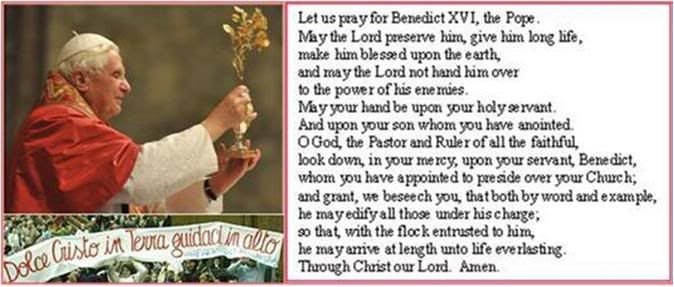


April 7
 ST. JOHN BAPTIST DE LA SALLE (France, 1651-1719)
ST. JOHN BAPTIST DE LA SALLE (France, 1651-1719)
Founder, Brothers of the Christian Schools
Patron Saint of Christian Teachers
OR for 4/6-4/7:
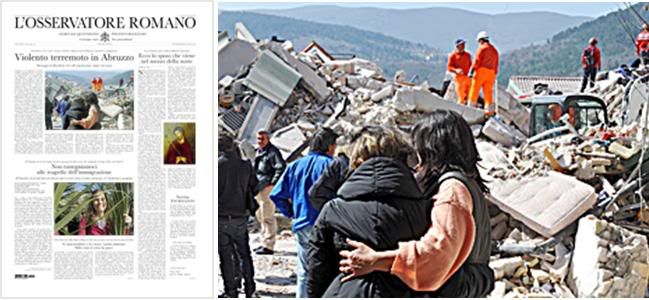
The earthquake in Italy's Abruzzo region is the main story. The issue highlights the Holy Father's Palm Sunday
homily and Angelus message, directed primarily at young people on the occasion also of the 24th World Youth Day,
and his meeting yesterday with some 7,000 Spanish youth who came to Rome to receive the WYD Cross and Icon
from an Australian delegation. Madrid will host WYD 2011.
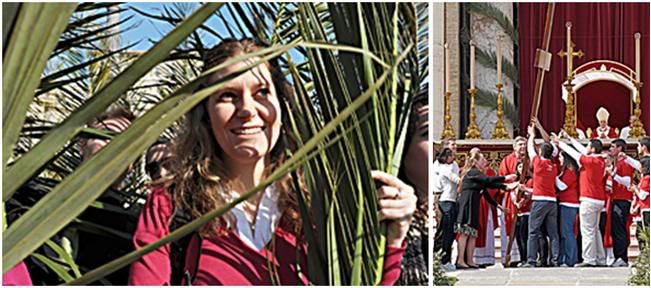
The Holy Father has no scheduled events today, but apparently, will hold his regular General Audience tomorrow.
[Modificato da TERESA BENEDETTA 07/04/2009 18:44] |
|
 07/04/2009 22:15 07/04/2009 22:15 |
|
| | | OFFLINE | | Post: 17.079 | Registrato il: 28/08/2005
| Utente Gold | |
|
 THE POPE'S HOLY WEEK LITURGY:
THE POPE'S HOLY WEEK LITURGY:
At the heart of the mystery of salvation
by Gianluca Biccini
Translated from
the 4/8/09 issue of

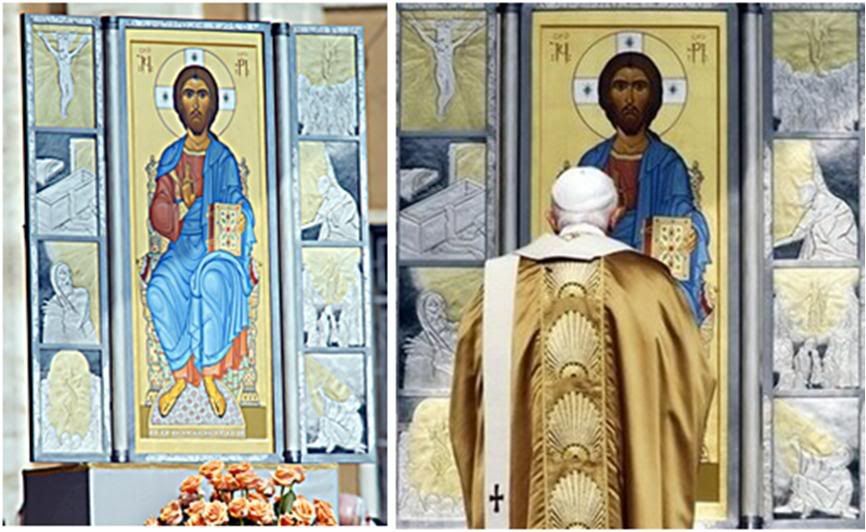 The 'new' Acheiropoieta, Vatican icon exposed on Easter Sunday.
The 'new' Acheiropoieta, Vatican icon exposed on Easter Sunday.
The Resurrexit* performed before the start of the Eucharistic celebration and a brief homily by Benedict XVI during the Mass are among the modifications in the liturgies presided over by Pope Benedict XVI on Easter Sunday.
[*I looked it up. The Resurrexit rite - descriptively called 'Peter, Witness of the Resurrection' - was first restored to the papal liturgy to precede Easter Morning Mass during the Jubilee Year of 2000, so I don't understand why it is considered a modification this year. Benedict XVI has always performed it as Pope, since 2006 (see photo above.]
In an interview with this newspaper, Mons. Guido Marini, ceremonial master of pontifical liturgies, explains these modifications as a renewal in continuity with tradition.
Could you explain a basic theme or guideline for the Sacred Triduum for 2009?
[The Triduum denotes the three days from the evening of Maundy Thursday to the evening of Easter Saturday. It begins with the evening Mass of the Lord's Supper of Holy Thursday) and ends after the Easter Vigil on Saturday night/Sunday morning of Easter.]
It is a line from the Gospel of St. John: "He loved them to the end" (Jn 13,1). Moreover, the rites of Holy Week lead us to the heart of the mystery of salvation, to the center of God's plan to save mankind.
Every celebration, in ways appropriate to its liturgical meaning - in words, gestures, silences, images, music and song - is meant to lead to a sorrowful contemplation of the mystery of human misery.
In turn, the latter is illumined by the mystery of the Savior's infinite mercy: the mystery of man only makes sense in Christ risen from the dead - as "the way, the truth and the life".
Therefore, everything [in the liturgy] should bring out the beauty of God's face whose features are truth and love, Truth which is Love - as the gospel says, "he loved them to the end".
What implications can these considerations have for the faithful in their day-to-day life?
Contemplation leads to practice. An attentive consideration of God's plan for salvation is authentic to the degree in which one follows, in his daily existence, the transition from sin to grace, from remoteness to nearness with God, from mediocrity to holiness.
Is this the relevance of Easter?
I would say so. By virtue of the liturgical celebrations, the mystery of Christ's passion, death and resurrection is not only a historic fact, but becomes an event of today, for every man, from which we can all draw in order to receive the gift of life. Christ risen from the dead is the Living One.
A month from the Pope's trip to the Holy Land, the references to the places of the Incarnation have a double resonance.
It is customary that the offerings collected during the Masses on Maundy Thursday are designated for a specific current need. This year, it is intended for the Christian community in Gaza.
Then, at the Via Crucis in the Colosseum, the last two persons to carry the wooden cross will be two Franciscans from the Custody of the Holy Land.
About the calendar of celebrations. It starts Thursday morning, April 9, with the Chrismal Mass in St. Peter's Basilica. What are the particulars of this rite that is so important to priests?
Concelebrating with the Pope will be 1600 diocesan priests and religious from various orders in the Diocese of Rome and the Roman colleges. They will be renewing their priestly vows. Then the Holy Father will bless the oils for the catechumens and the sick, and the Chrism [perfumed oil used for Baptism, Confirmation and Holy Orders].
The presentation of the oil of the catechumens will be dome by some neophytes who will be baptized at the Easter Vigil; the oil for the sick, by some sick persons who will be receiving Holy Unction; that of the Chrism, by young people who are candidates for confirmation and two deacons who are about to enter Holy Orders.
Three of the amphorae containing the oils were designed by Mario Toffetti, who also designed the baptismal font to be used in the Easter Vigil and used in the baptisms held in the sine Chapel. The three other oil containers, in silver, were a gift from Spain given several years ago.
The oils [pure olive oil] are a gift from the cooperative Arte e alimentacio SL of Castelseras, Spain; and the perfumed essence for the Chrism, from a consortium of bergamot growers from Reggio Calabria.
At the end of the Mass, the consecrated oils will be brought to the Basilica of St. John at the Lateran, where they will be distributed among the parishes and priests of the diocese to be used for administering the Sacraments during the year.
And in the evening, the Pope will be offering the Mass of the Lord's Supper at the Lateran, the cathedral of Rome, where the offerings will also be destined for the Christians of Gaza. Beyond the washing of the feet, what will be the other characteristics of this celebration?
The Pope will be seated at the papal cathedra: the one in St. John Lateran is in fact the Cathedra of the Bishop of Rome. He will wash the feet of 12 priests, who are canons of the Basilica, thus repeating the gesture of Jesus towards the Twelve Apostles, a revelation of the mystery of Christ and a sign of his absolute giving of himself.
Also, following custom, the Holy Father will give Communion to members of the diplomatic corps accredited to the Holy See. After the Mass, there will be the brief Procession of transferring the Blessed Sacrament to the altar of the Reposition in the Chapel of St. Francis.
There will be two events on Good Friday, April 10. First, the comeemoration of the Passion at St. Peter's Basilica, and then the Via Crucis at the Colosseum. What unites the two events?
The centrality of the Cross. The dimmed lights in St. Peter's at the morning celebration will be a sign of the penitential character of the rite. At the start, Benedict XVI will kneel before the Cross in silent prayer, a sign of penitence and asking the Lord for pardon.
Then he will raise the Cross for the adoration of the faithful, after which, he will kiss it in reverence. he will do this with his shoes off. The Cross to be used dates back to Leo XIII.
The Gospel account of the Passion will be sung by three deacons with the assistance of the Sistine Chapel choir. The homily will be delivered by Fr. Raniero Cantalamessa, preacher of the Pontifical Household.
The papal chair will be placed in front of the statue of St. Peter in the central nave of the Basilica. The Pope will be assisted by two cardinal deacons p Stanislaw Rylko and Giovanni Lajolo.
As for the Via Crucis, everyone knows now that the text of the meditations and prayers were prepared by the Salesian Bishop of Guwahati, in India, Mons. Thomas Menamparampil. The images to illustrate the libretto are typical of Indian art and were executed by Sr. Marie Claire Naidu, of the Church of the Assumption in Bangalore, India.
In the Colosseum itself, the Cross will be borne successively by the Cardinal Vicar of Rome, Agostino Vallini; a Roman family; two Indian nuns and an Indian girl; a handicapped person; two African girls; a patient on a wheelchair accompanied by two assistants; and the two Franciscans from the Holy Land.
On Saturday night, starting at 9 p.m., the Easter Vigil - which St. Augustine called the mother of all vigils' - will start at St. Peter's. Are there any special details?
The rites will start at the atrium of the Basilica, where the Pope will bless the Easter fire and light the Paschal candle (as has become customary, this will be prepared by the Neo-Catechumenal Way)'
In the basilica, the passage from total darkness to light symbolizes the entry of the Light of Christ - way, truth and life - into the dark and shadow-filled world of sin, solitude and death.
The Pope will administer Baptism, Confirmation and the First Communion to 5 adult catechumens prepared by the Vicariate of Rome - two men and three women, one of whom is a 57-year-old Chinese lady. They will be receiving Communion in both species (bread and wine), Body and Blood of the Lord.
Toffetti's baptismal font will be set up at the foot of the Altar of Confession [main altar] with the Paschal candle next to it. This underscores the importance of the baptismal rite in the liturgy of the Easter Vigil.
The final rite will be the Mass of the Resurrection on St. Peter's Square which will be decorated with tulips from Holland, as usual, offered every year by Dutch Catholics.
But this year, the celebration will begin with the rite of the Resurrexit, with the opening of an image of the Risen Christ. [It recalls Peter seeing the Risen Christ for the first time]. The image is the 'new Acheiropoieta' [term for an image 'not made by human hands'], which is an icon replicating the medieval prototype.
The image shows the Savior seated on a throne, with two side panels [which, when folded inward, serve to conceal the image].
[A description of the rite:"At the beginning of the Mass two deacons open the doors of the venerable icon of Christ the Savior (Acheiropoieta = not made by human hands), after which one of the deacons proclaims in song the news of the Lord’s Resurrection: first to the assembly with the chant Surrexit Dominus de sepulcro, qui pro nobis pependit in ligno, and then to the Holy Father, with the words Surrexit Dominus vere et apparuit Simoni].
In much earlier times, this rite was done before the Mass and separate from it, in the Lateran Basilica, from which the Pope then went in procession to Santa Maria Maggiore to say Mass.
This year, the Pope will also perform the rite of aspersion [sprinkling with holy water] as a reminder that baptism is a penitential act and an introduction to the celebration of the Mysteries of the Lord in the Mass.
Also, for the first time, the Pope will give a brief homily. [This was previously omitted because after the Mass, the Pope delivers his Urbi et Orbi message from the central loggia of St. Peter's.]
Finally at the end of the Mass - where the Pope will be assisted by two cardinal deacons, Agostino Cacciavilli and Julian Herranz - the Holy Father will impart his Urbi et Orbi blessing from the central loggia of St. Peter's.
Holy Week in the Byzantine tradition:
Here is the Spouse who comes
in the middle of the night!
by Manuel Nin
Translated from
the 4/7/09 issue of

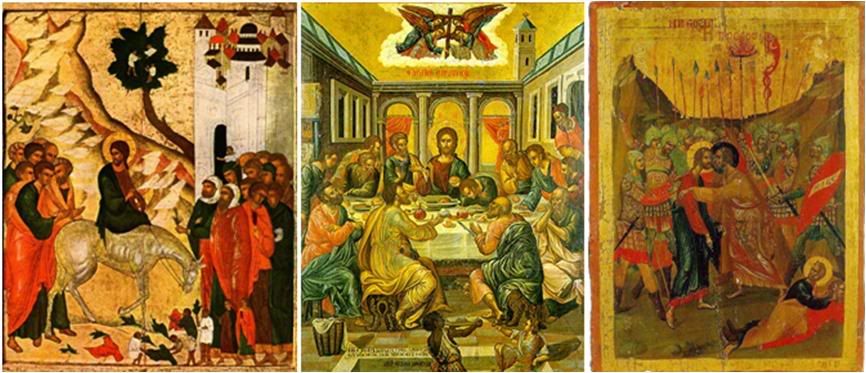
In the Byzantine tradition, the week that precedes Palm Sunday practically turns its back on Lenten penitence to contemplate the Lord who comes up to Jerusalem to be crucified and to rise from the dead.
It is a week which followa the footsteps of Jesus in the final sYA of his life: the liturgixal texts take us along his journey in a very pedagogical way, but above all, to that event which will be fully manifested in Holy qeek - the philanthropy of God manifested in Jesus Christ, his real and concrete love for mankind.
Already by the fourth century, the resurrection of Lazarus by Jesus was celebrated in Jerusalem before Palm Sunday. On the Wednesday before Palm Sunday, both the dead Lazarus (brother to Martha and Mary of Bethany) and the poor Lazarus of the parable are evoked in the morning troparion [hymn chanted between verses of Scripture]:
"The Pharisees, dressed in purple and silk, have the Laws and the Prophets for a treasure. They had you crucified, Poor One, outside the gates of the city, and rejected you, despite your resurrection, you who are ever close to the Father. Grace will be for them as the drop of water desired by the merciless rich man, and they will see a multitude of pagans in the womb of Abraham, clad in baptismal garments and the red of your blood."
The following day, Thursday, the liturgy already underscores Christ's victory over death. On Friday, it mixes joy over the imminent resurrection of Lazarus and that over Jesus's entry into Jerusalem. And on Saturday, it joins Lazarus's resurrection with that of Jesus: "You wished to see the tomb of Lazarus, O Lord, you who are about to inhabit a tomb yourself".
The entire sixth week of Easter is framed in this imminent encounter between Jesus and death - that of his friend, first, and then the following week, his own.
Thus, in his philanthropy towards his friend Lazarus, he gives us a foretaste of the great philanthropy of God which will be revealed on the Cross.
Palm Sunday ends Jesus's ascent towards Bethany and Jerusalem, and starts his ascent towards the Cross. Jesus's royal entry is seen as a consequence of his recent victory over death, that of Lazarus, and there is a new theophany: "He who has heaven for his throne and the earth as his footstool - the Word of God the Father, the co-eternal Son - comes today to Bethany, humbly sitted on a donkey's colt. You who are borne by cherubim and exalted by the seraphim, like David, you ride an ass, o Good One."
The celebration of Jesus's entry into Jerusalem is clear: an entry like a King, but his entry in humility into the sacramental life of the Christian community, into the life of every Christian and every man.
In the first three days of Holy Week itself, Byzantine liurugy highlights the role of Jesus as Spouse, and therefore, the marriage of God with the Church and with mankind. This is common to all the Oriental liturgies: The Syriac tradition has a celebration 'of the lamps' during which the parable of the ten virgins is acted out in church.
These first three days also commemorate some other personages.
On Holy Monday, it is the patriarch Joseph, as a prefiguring of Jesus, sold by his brothers into suffering, then exalted by God to be the savior of his people.
On Holy Tuesday, in the context of the 'spouse'image - the ten virgins of the parable.
On Holy Wednesday, the sinner who anointed Jesus's feet with perfumed oil and her tears - both of them baptismal symbols - in touch with the incarnate Christ, the Spouse who is preparing to meet his bride the Church.
Two texts focus the officiation of rites on these three days:
"Here is the Spouse who comes in the middle of the night: Blessed is the servant whom he will find watchful, unworthy the servant whom he will find negligent. Therefore watch out, my soul, and do not let yourself be oppressed by sleep so you will not be sent to death and locked out of the Kingdom. But while watching, shout: You are holy, holy, holy, Lord. Through the intercession of the Mother of God, have mercy on us".
The second troparion is a counterpoint: "I see your bridal bed adorned, O my Savior, and I do not have the garments to come in. Make the garments of my soul shine, you who gives the light, and save me".
The expectation of the encounter with the old Adam chased out of Psaradise at the start of Lent now becomes much more urgent and joins the image and evangelical theme of the arrival and meeting with the Spouse who comes in the middle of the night and whose nuptial bed is, uniquely, the Cross.
On Maundy Thursday, several events are commemorated: the washing of feet, the Last Supper, Jesus's prayer in the Garden of Olives, and the betrayal by Judas. The liturgical texts highlight the role of Judas as traitor and exhorts every Christian against the possibility of betraying he who is calling us and who has becoem both our servant adn our friend. Vespers are celebrated in the morning, with the liturgy of St. Basil and the washing of feet (only in bishop's cathedrals and in the monasteries).
"While the glorious disciples were enlightened with the washing of feet, the shdaows descended on Judas, the unholy one sickened by greed. And he delivers you, the just judge, into the hands of unworthy judges. Look at this slave to money, who ends up hanging himself! And so escapes the insatiable soul who dared such things against the Master!"
In this troparion which opens the morning's divine office, the terms 'enlightened' and 'washing' are to be understood in clearly baptismal terms: and as Judas fades into the night, the other disciples are enlightened.
[Modificato da TERESA BENEDETTA 08/04/2009 10:52] |
 08/04/2009 09:43 08/04/2009 09:43 |
|
| | | OFFLINE | | Post: 17.082 | Registrato il: 28/08/2005
| Utente Gold | |
|
 What has (not) changed
What has (not) changed
from John Paul Ii to Benedict XVI?
by Bruno Mastroianni

April 7, 2009
Ont he anniversary of John Paul II's passage to heaven, the Belgian parliament voted a resolution calling on the government to protests the statements made by Benedict XVI recently about condoms.
This thing about governments and institutions 'rising up' against the Pope is new! One would think Benedict XVI has been saying things that are radically different from what his predecessor used to say.
But in fact, between the two Popes is a total continuity of content. Even about the fight against AIDS, John Paul said the same things.
So what has changed? It must be the way each Pope presents his ideas.
Papa Wojtyla was capable of significant visible gestures and transmitted Christianity by his very physicality. Everyone remembers him for being charged with empathy. [I find this argument questionable. Physicality and empathetic gesture hardly made John Paul II's statements about condoms - which touches ideological open nerves - any more acceptable.]
Benedict is different. His style is to propose the truth of the faith through the force of intelligence. He says things clearly and bluntly, but without imposing, in his cal and serene manner.
He appeals to the rationality of his listeners. He presents his message with the disarming humility of one who trusts his audience.
But in doing so, he also sows a crisis in the indifference of politically correctness that haunts Europe above all. Thus, the institutionalizes reaction which, nor surprisingly, comes mostly and most forcefully from the Old Continent. [Also, most stupidly! What kind of Parliament does not have a single member capable of Googling facts about condoms against AIDS in Africa, about which anyone can find a lot, pro and con.]
But a comparison with Papa Wojtyla shows a Pope who was not any less intransigent. During his Pontificate, there were those defined the relationship between the Pope and Cardinal Ratzinger as a winning tandem. The tandem has evolved into an extraordinary relay.
|
 08/04/2009 10:36 08/04/2009 10:36 |
|
| | | OFFLINE | | Post: 17.084 | Registrato il: 28/08/2005
| Utente Gold | |
|

April 8, Wednesday
 St. Julie Brilliart (1751-1816)
St. Julie Brilliart (1751-1816)
Founder, Sisters of Namur (France)
OR today.
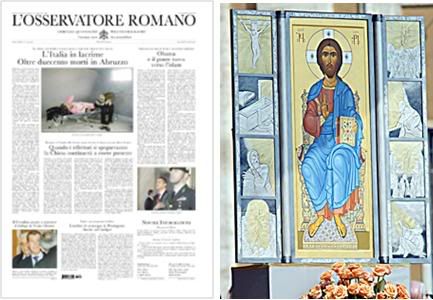 Illustration: Acheiropoetia for Easter, Vatican icon.
Illustration: Acheiropoetia for Easter, Vatican icon.
Main story continues to be the earthquake in Italy's Abruzzo region, with
the dead now numbering over 200 - continuing aftershocks felt even in Rome;
a separate story on the activities of the Church in aid of the victims. Other
stories: Obama and Turkey as a bridge to Islam; Kremlin says it supports
Israeli-Palestine dialog in the Middle East; the Pentagon makes large budget
cuts with a change in strategy under Obama.
THE POPE'S DAY
General Audience today - The Holy Father speaks on the significance of the Paschal Triduum
and announces he hopes to visit the earthquake victims of Abruzzo as soon as possible.
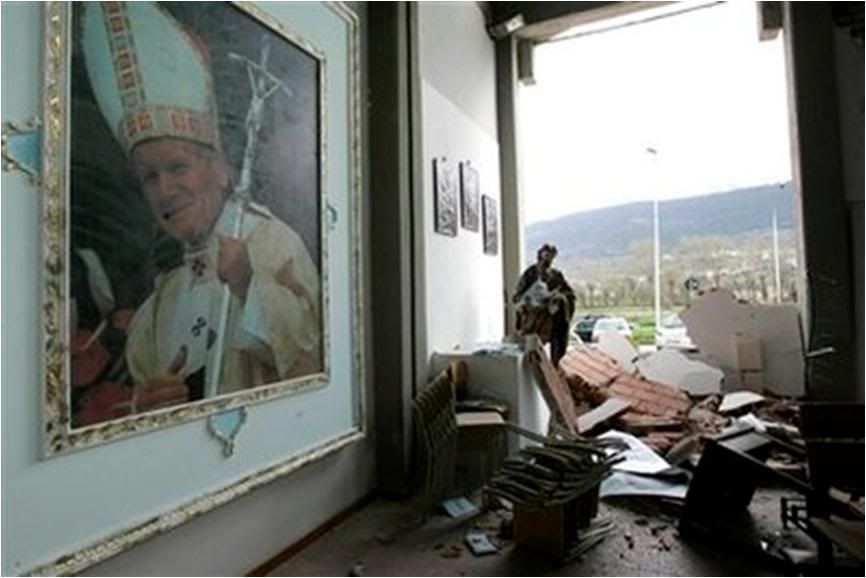 Quake-damaged church in Sant'elia, a village near L'Aquila, capital of the Abruzzo region and epicenter of the earthquake.
Quake-damaged church in Sant'elia, a village near L'Aquila, capital of the Abruzzo region and epicenter of the earthquake.
[Modificato da TERESA BENEDETTA 08/04/2009 13:07] |
 08/04/2009 12:15 08/04/2009 12:15 |
|
| | | OFFLINE | | Post: 17.085 | Registrato il: 28/08/2005
| Utente Gold | |
|
 Montage includes cover illustrations for the Via Crucis of 2005, 2006, 2007, 2008 and 2009, respectively.
VIA CRUCIS 2009
Montage includes cover illustrations for the Via Crucis of 2005, 2006, 2007, 2008 and 2009, respectively.
VIA CRUCIS 2009
The Vatican has posted online the Meditations and Prayers for the 2009 Via Crucis at the Colosseum, prepared by
Mons. Thomas Menamparapil, Bishop of Guhawati (India).
www.vatican.va/news_services/liturgy/2009/documents/ns_lit_doc_20090410_via-crucis...
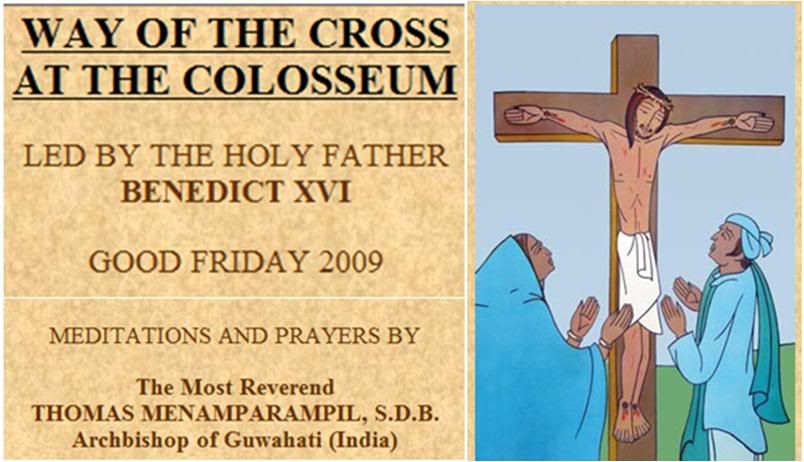
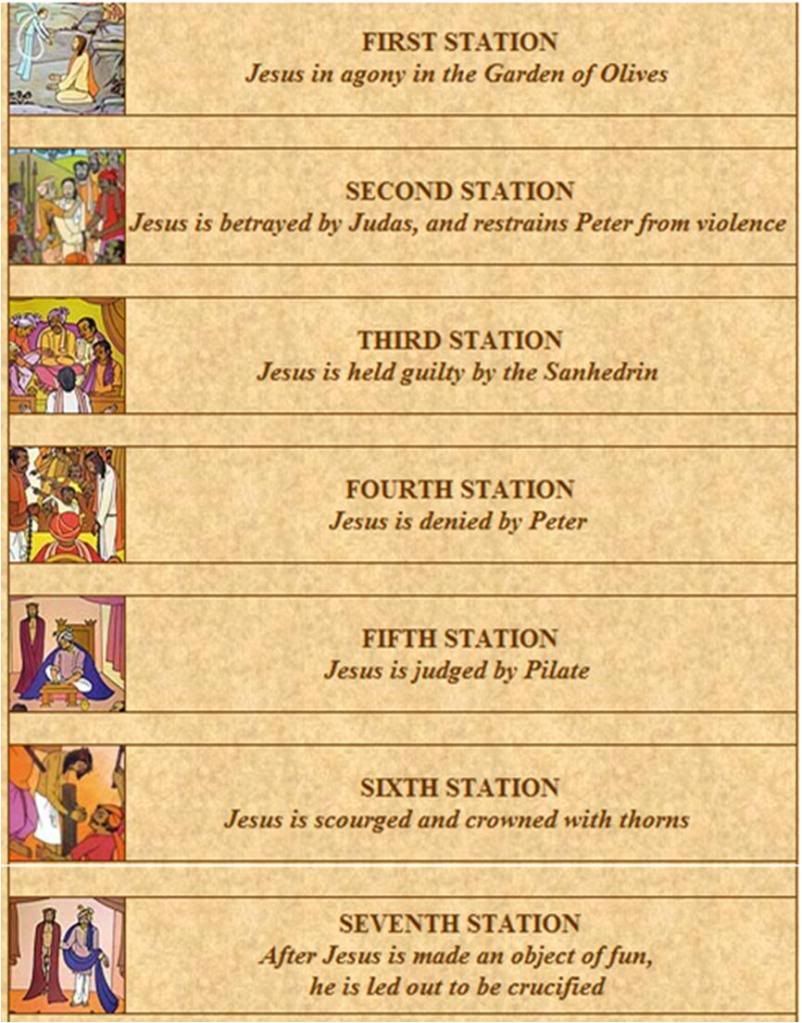
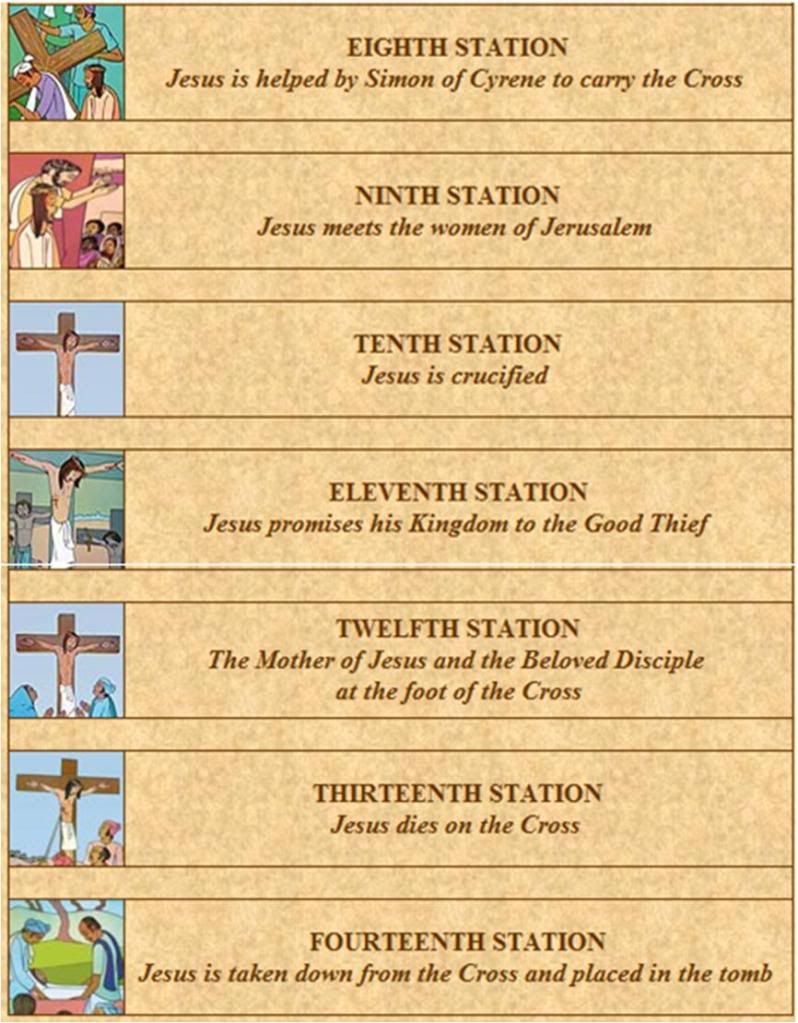
The illustrations for the 2009 Via Crucis libretto were executed by Sr. Marie Claire Naidu 'in the second half of
the 20th century' for the Church of the Assumption in Bangalore, India.
Vatican's Good Friday will focus
on Christian persecutions in India

Vatican City, April 8 (dpa) - The faithful will be invited to reflect on the persecution of Christians in India in prayers at this year's traditional Good Friday Way of the Cross ceremony at Rome's Colosseum, the Vatican said Tuesday.
Pope Benedict XVI is set to preside the evening ceremony - also known as Via Crucis - which commemorates Jesus' final hours including his crucifixion.
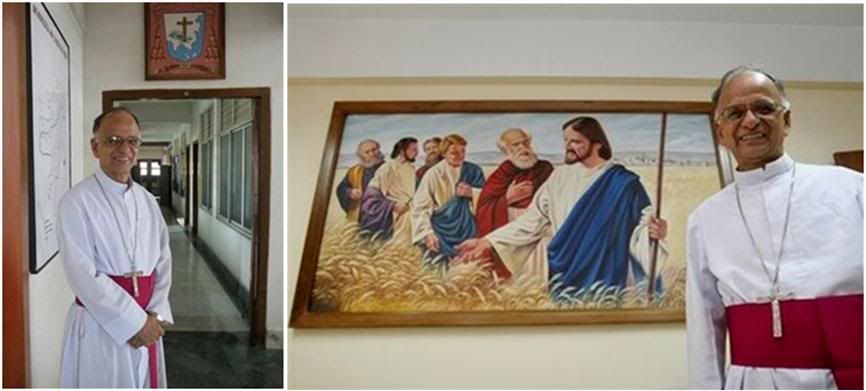
Archbishop Thomas Menamparampil of Guwahati, India, was asked by the Pope to write the meditations and prayers for this year's Via Crucis which will focus on "evil in the world, on pain and on the various forms of suffering," the Vatican said.
"In this context, he (Menamparampil) will also refer to Christians who suffer persecution in India and in other countries, as well as to the violence that destroys ethnic and religious groups, and to conflicts fuelled by economic interests," the Vatican said.
Violence aimed at Christians have increased in India in recent years including in the eastern state of Orissa, which witnessed widespread anti-Christian violence after the August 23, 2008 murder of Hindu leader Laxmananda Saraswati an attack police blamed on Maoist rebels.
Nearly 40 people, mostly Christians, were killed in the Hindu-Christian violence in the state that continued over two months.
The Vatican notes how for the "second consecutive year, the Pope wishes to draw attention to the continent of Asia" given that last year the Way of the Cross prayers then penned by Hong Kong's Cardinal Joseph Zen Ze-kiun also focused on the "persecutions the Catholic Church faces in various part of the world."
[Modificato da TERESA BENEDETTA 08/04/2009 13:08] |
 08/04/2009 14:42 08/04/2009 14:42 |
|
| | | OFFLINE | | Post: 17.087 | Registrato il: 28/08/2005
| Utente Gold | |
|
 GENERAL AUDIENCE TODAY
GENERAL AUDIENCE TODAY


The Holy Father today spoke about the significance of the Paschal Triduum which begins tomorrow, at his catechesis for the General Audience in St. Peter's Square today.
Here is how he synthesized it in English:
Tomorrow we begin the Holy Triduum, the heart of the entire liturgical year: a time when we immerse ourselves in the central events of our Redemption.
The Chrism Mass serves as a prelude to these three days, as priests renew their promises to the Bishop, who then blesses the holy oils and consecrates the chrism signifying the gift of the Holy Spirit.
At the Mass of the Lord’s Supper, we recall the institution of the Eucharist, the supreme sign of Christ’s love for us.
As we venerate his Cross on Good Friday, we contemplate the full meaning of his words: "This is my blood of the covenant, which is poured out for many" (Mk 14:24).
Holy Saturday finds us waiting in silent hope for the Easter Vigil, when every church will break forth in a song of joy at the Lord’s Resurrection.
The celebration of the Paschal mystery recalls the depth of Christ’s love: he did not wish to exercise his divinity as an exclusive possession, a means of domination, or a sign of distance between him and us.
Rather, "he emptied himself, taking the form of a servant" (Phil 2:7) by sharing fully in our human condition, even to the point of death: not a death imposed by blind chance or fate, but one freely chosen in obedience to the Father’s will for the salvation for all.
May our fervent celebration of the Triduum draw us ever more deeply into Christ’s Paschal mystery!
I am pleased to greet the English-speaking pilgrims present at today’s Audience. May your visit to Rome during this Holy Week fill you with the peace, hope and joy of Christ Jesus!
POPE WILL VISIT
EARTHQUAKE VICTIMS
At the end of his multilingual greetings, the Pope once again expressed his spiritual closeness to the people of the Abruzzo region hit by a severe earthquake, and promised he would visit them as soon as possible.
Father Federico Lombardi, Vatican press director, said, it would be soon after Easter Sunday.
Here is a translation of what the Holy Father said in this regard:
I renew my expression of spiritual closeness to the dear community of L'Aquila and other towns that were severely struck by the violent earthquakes in the past few days, resulting in numerous victims, so many more injured, and heavy material damages.
The care and concern shown by the authorities, the forces of law and order, volunteers and other workers who are helping our brothers dmeonstrated the importance of fraternal solidarity to overcome such painful occurrences.
Once again I wish to tell those beloved populations that the Pope shares their pain and their concerns. Dearest ones, as soon as possible, I hope to come and visit you.
Know that the Pope is praying for everyone, imploring the Lord's mercy for those who died, and for their relatives and other survivors, the maternal comfort of Mary and the support of Christian hope.
The Pope usually goes to Castel Gandolfo for a few days rest following his heavy Holy Week schedule of public events.
Additionally, he will mark his 82nd birthday on Thursday, April 16, and the fourth anniversary of his Pontificate on Sunday, April 19.
 online has the following added information:
online has the following added information:
Benedict XVI announced his intended visit earlier in a telephone call to the Bishop of L'Aquila, Mons. Giuseppe Molinari "to express once more and in person his own participation in the pain of the event and to ask for more information on what is happening", according to Fr. Federico Lombardi, Vatican press director.
He added: "The Pope also directly expressed his intention of going there as soon as possible".
Fr. Lombardi said that "it will not be before Easter, and we will fix the date in consultation with Italian authorities and security", saying the Pope does not want the visit to interfere with rescue and assistance operations.
The spokesman for the diocese of L'Aquila said it was possible the visit would be early next week, "but we must see how the situation develops".
Part of the uncertainty is due to the medium-to-high intensity aftershocks that continued up till last night and difficulties in rescue and assistance operations.

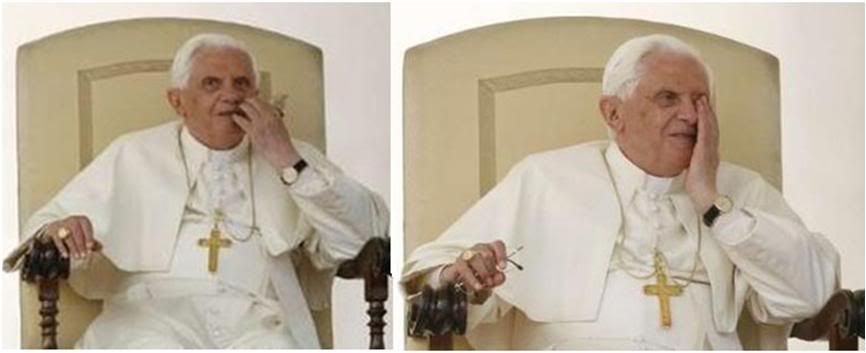
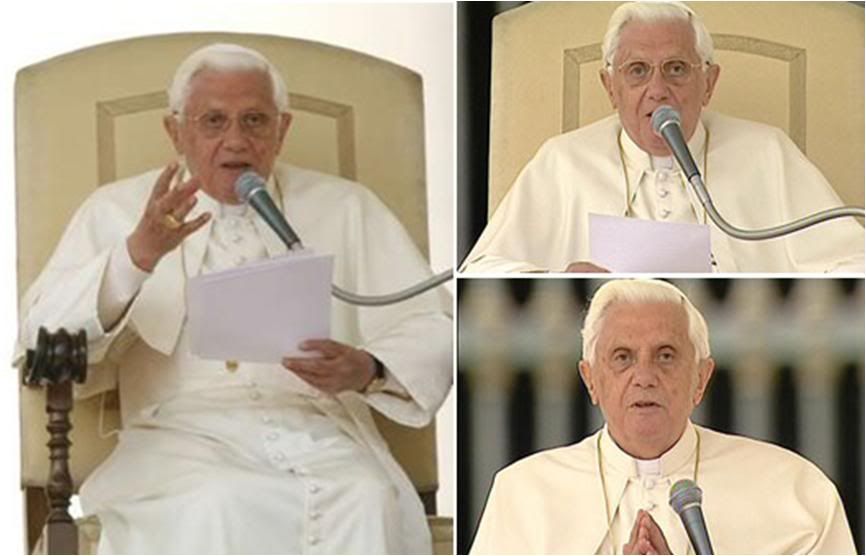 Here is a full translation of the Holy Father's catechesis:
Here is a full translation of the Holy Father's catechesis:
CATECHESIS ON THE PASCHAL TRIDUUM
Dear brothers and sisters,
Holy Week, which for us Christians is the most important week of the year, offers us the opportunity to immerse ourselves in the central events of the Redemption, to re-live the Paschal mystery, the great mystery of the faith.
Starting tomorrow afternoon, with the Mass of the Lord's Supper, the solemn liturgical rites will help us to meditate more vividly on the passion, death and resurrection of the Lord on the days of the Holy Paschal Triduum, the fulcrum of the entire liturgical year.
May the divine grace open our hearts to understanding the inestimable gift of salvation obtained for us by the sacrifice of Christ. We find this immense gift described wonderfully in the famous hymn from St. Paul's Letter to the Philippians (cfr 2,6-11), which we have meditated on many times during Lent.
The apostle reviews, in a way that is as essential as it is effective, all the mystery of the story of salvation, citing the arrogance of Adam who, not being God, wished to be like God.
And he contrasts this arrogance of the first man - which all of us feel a bit in our being - the humility of the true Son of God who, having become man, except for sin, pushed himself to the depths of death.
This descent to the ultimate depth of suffering and death is followed by his exaltation, true glory, the glory of love which gives to the end.
It is therefore right, as Paul says, "that at the name of Jesus every knee should bend, of those in heaven and on earth and under the earth, and every tongue confess that Jesus Christ is Lord" (2,10-11).
St. Paul refers, with these words, to a prophecy of Isaiah where God says, "I am God... To me every knee shall bend" (cfr Is 45, 23). This, says Paul, applies to Jesus Christ. It is truly he, in his humility, in the true greatness of his love, who is the Lord of the world, and before him every knee should bend.
How marvelous, as well as surprising, is this mystery! We can never sufficiently meditate on this reality. Jesus, although he was God, did not wish to keep his divine prerogatives as his exclusive possession. He did not want to use his being God, his glorious dignity and his power, as an instrument of triumph and a sign of distance from us.
On the contrary, "he emptied himself", assuming the misery and weakness of the human condition - and here, Paul uses a Greek word pregnant with meaning, kenosis, for this descent by Jesus.
Divine form ( morphe) concealed itself in Jesus under human form - that is, under our reality which is marked by suffering, poverty, our human limitations, and death.
This radical and true sharing of our nature, sharing everything except sin, led him to that frontier which is the sign of our finiteness, death.
But all this was not the fruit of some obscure mechanism or blind fatality: it was, rather, his free choice, out of generous adherence to God's plan for salvation.
The death towards which he went, Paul says, was that on the cross, the most humiliating and degrading that one can imagine. All this, the Lord of the universe fulfilled out of love for us. Out of love, he wished to empty himself and make himself our brother. Out of love, he shared our human condition, that of every man and every woman.
A great witness of the Oriental Christian tradition, Theodoretus of Ciro, wrote about this: "Being God, and God by nature, and being equal to God, he did not consider this of any importance, as those who receive any honor above their true merits, but hiding his own merits, he chose the most profound humility and took the form of a human being" (Commentary on the Letter to the Philippians, 2,6-7).
A prelude to the Paschal Triduum which, as I said, starts tomorrow with the evocative afternoon rites of Maundy Thursday, is the solemn Mass of the Chrism, which in the morning, the Bishop celebrates with his own priests, during which together, they will renew the priestly vows they made on the day of their ordination.
It is a gesture of great value, an occasion that could not be more propitious for priests to reaffirm their faithfulness to Christ who chose them to be his ministers.
This priestly gathering additionally takes on a particular significance at this time, because it is almost like a preparation for the Year of the Priest that I declared on the occasion of the 150th death anniversary of the Holy Curate of Ars (St John Vianney) and which will start on June 19.
Also at the Chrismal Mass, the oils for the sick and for catechumens will be blessed, and the Chrism will be consecrated.
These rites symbolically stand for the fullness of Christ's Priesthood and that ecclesial communion that should animate the Christian people, gathered together for the Eucharistic sacrifice and revived in unity by the gift of the Holy Spirit.
In the afternoon Mass, called 'in Coena Domini' (of the Lord's Supper), the Church commemorates the institution of the Eucharist, the priestly ministry, and the new commandment of love left by Jesus to his disciples.
About what happened in the Cenacle on the eve of the Lord's passion, St. Paul offers one of the oldest testimonies. He writes:
...the Lord Jesus, on the night he was handed over, took bread, and, after he had given thanks, broke it and said, "This is my body that is for you. Do this in remembrance of me."
In the same way also, he took the cup, after supper, saying, "This cup is the new covenant in my blood. Do this, as often as you drink it, in remembrance of me." (1Cor 11,23-25)
Words charged with mystery, which manifest clearly what Christ wanted:Iin the form of bread and wine, He makes himself present, giving up his body and shedding his blood. It is the sacrifice of the new and definitive covenant offered to everyone, without distinction of race or culture.
For this sacramental rite, which he hands over to the Church as the supreme proof of his love, Jesus made his disciples ministers, along with all those who would follow such ministry in the course of centuries.
Thus, Maundy Thursday constitutes a renewed invitation to give thanks to God for the supreme gift of the Eucharist, to be received with devotion and to be adored with sincere faith.
That is why, the Church encourages, after the celebration of the Holy Mass, a prayer vigil in the presence of the Blessed Sacrament to remember the sad hours Jesus spent in prayer at Gethsemane before he was arrested and eventually sentenced to death.
And so we come to Good Friday, the day of the passion and crucifixion of the Lord. Every year, in silence before Jesus suspended from his wooden Cross, we realize how full of love were the words he said during the Last Supper: "This is my blood of the covenant, which will be shed for many" (cfr Mk 14,24).
Jesus offered his life in sacrifice for the remission of man's sins. Just as it is in front of the Eucharist, so too, in the face of the passion and death on the Cross of Jesus, the mystery becomes unfathomable to reason.
We are before something which appears humanly absurd: a God who not only becomes man, with all the needs of man; who not only suffers to save man by taking upon himself all the tragedy of mankind, but dies for man.
The death of Christ reminds us of the accumulation of sorrows and evils that have weighed on man at all times: the crushing weight of our death, the hatred and the violence that continue to make the earth bloody. The passion of the Lord continues in the suferrings of man.
As Blaise Pascal rightly wrote, "Jesus will be in agony even to the end of the world. We must not sleep during that time." (Pensees, 583)
If Good Friday is a day full of sorrow, it is at the same time the day most propitious to reawaken our faith, to consolidate our hope and the courage for each of us to carry our own cross with humility, trust and abandonment to God, certain of his support and his victory.
The liturgy of this day sings, " O Crux, ave, spes unica – Ave, o croce, unica speranza!" (Hail, O Cross, the only hope).
This hope is nourished in the great silence of Holy Saturday, in expectation of the resurrection of Jesus. On this day, the churches are stripped bare and no particular liturgical rites are prescribed.
The Church keeps vigil in prayer like Mary, and with Mary, sharing her sentiments of sorrow and trust in God. Rightly, it is recommended to keep a prayerful atmosphere throughout the day, one that is favorable to meditation and reconciliation.
The faithful are encouraged to approach the sacrament of Penitence, in order to be able to participate truly renewed in the Easter celebrations.
The meditation and silence of Holy Saturday lead to the solemn Easter Vigil that night, 'the mother of all vigils', when the song of joy over the resurrection of Christ erupts in all churches and communities .
Once more, the victory of light over shadows will be proclaimed, that of life over death, and the Church will rejoice in her encounter with the Lord. Thus we enter the climate of Easter, the Sunday of Resurrection.
Dear brothers and sisters, let us prepare ourselves to experience the Holy Triduum intensely, so that we may participate evermore profoundly in the Mystery of Christ.
May the Blessed Virgin accompany us on this itinerary, she who followed her son Jesus in silence up to Calvary, taking part with great pain in his sacrifice, thus cooperating in the mystery of Redemption and becoming the Mother of all believers (cfr Jn 19,25-27).
Together with her, let us enter the Cenacle, let us stay at the foot of the Cross, let us keep vigil ideally next to the deceased Christ, awaiting with hope the dawn of the radiant day of Resurrection.
In this regard, I express to all of you my most heartfelt wishes for a joyous and holy Easter together with your families. parishes and communities.


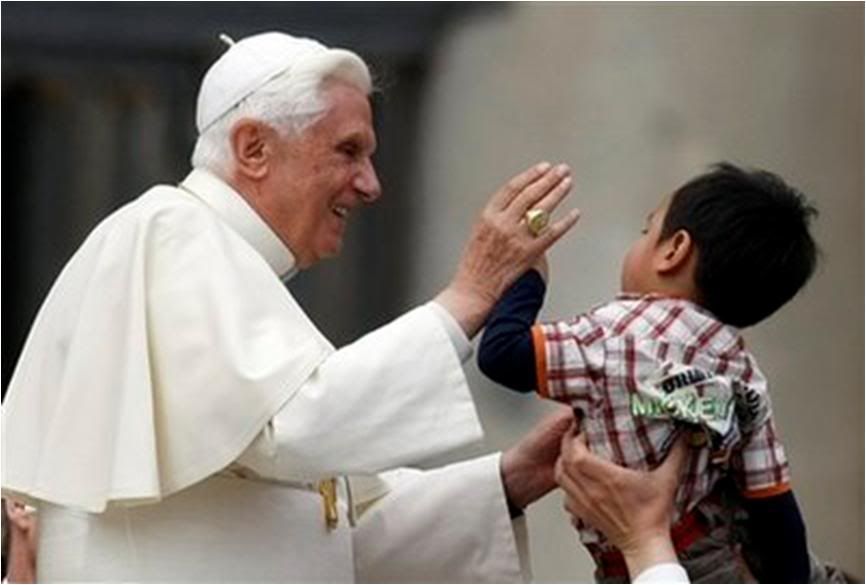
[Modificato da TERESA BENEDETTA 08/04/2009 18:15] |
 08/04/2009 20:08 08/04/2009 20:08 |
|
| | | OFFLINE | | Post: 17.089 | Registrato il: 28/08/2005
| Utente Gold | |
|

 Prince behind 'A Common Word'
Prince behind 'A Common Word'
to host the Pope on his visit
to the baptismal site of Jesus

ROME, April 8 (Translated from ASCA) - During his visit to Jordan on May 8-11, Pope Benedict XVI will meet with Prince Ghazi bin Muhammad bin Talal, who started the initiative (and is the primary signatory) for the October 2007 letter A Common Word initially signed by 138 Muslim religious leaders and intellectuals, and is one of the closest advisers to his cousin, King Abdullah II of Jordan.
This was announced by the Jordanian Minister of Tourism at a news conference in Jordan's embassy to Italy today.

Prince Ghazi, born in 1966, was educated in Princeton and Cambridge, with degrees in literature and in medieval and modern languages. He is also the chairman of the Royal Aal-Al Bayt Institute for Islamic Thought based in Amman, the umbrella organization for A COMMON WORD.
The prince will be accompanying the Pope when he visits Bethany beyond the Jordan, thought to be the site of Jesus's Baptism. Prince Ghazi was the principal sponsor of the construction there of a baptism center for Christians, which he inaugurated last March along with former British Prime Minister Tony Blair.
"Jordan can be a model for religious tolerance and inter-religious dialog," said Madame al Khatib, who met newsmen after meeting the Pope this morning following the General Audience.
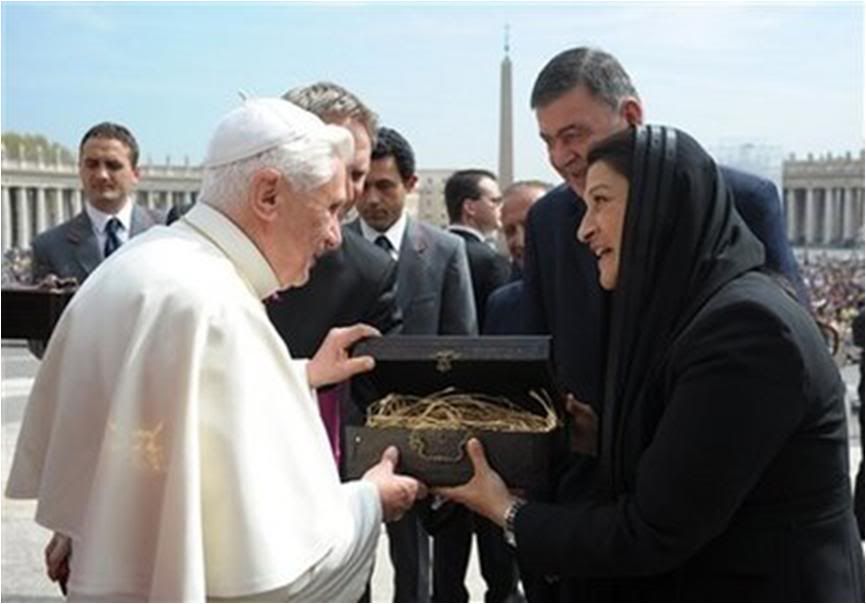
"Our Constitution provides for freedom of worship and religion, and many of our high functionaries are involved in inter-religious dialog", she pointed out.
The Pope will be visiting Jordan before proceeding to Israel and the Palestinian territories during his May 8-15 pilgrimage to the Holy Land, his first as Pope.
Can anyone hazard a guess what is contained in the gift chest presented by the minister to the Pope? They look like chains and ropes of gold to me! (It could also be 'straw' packing for something breakable.)
Somehow, I like the idea of having the Pope wear his pectoral crosses on a chain given to him by a Muslim (especially since Arab goldsmiths generally use only 24-karat gold), just as for years he wore a pectoral cross that belonged to the father of a Greek Orthodox friend of his.
***
It turns out that tomorrow's issue (4/9/09) of L'Osservatore Romano also carries a story about the Jordanian minister with a completely different angle, and without any mention of Prince Ghazi. The picture that OR uses was obviously taken before the picture it released to the wire services used with the story above.
Jordanian minister tells Pope
so many Muslims are awaiting his visit
Translated from
the 4/9/09 issue of


"In Jordan, the Muslims are awaiting the Pope as much as the Christians", said the Jordanian Minister for Tourism and Antiquities
Madame Maha Khatib, who was at the General Audience in St. Peter's Square yesterday.
After the catechesis and his multilingual greetings to the faithful, Pope Benedict XVI was able, as is customary, to meet some of the pilgrims, including sick persons and newlyweds, with tickets allowing them to be near the Pope when he walks about to greet the faithful.
Among them was Minister Khatib, who was accompanied by engineer Rustom Moukhjian, an Orthodox Christian in charge of the archeological site thought to be the place where Jesus was baptized (Bethany beyond the Jordan) and by Tayseer Ammary, a Catholic adviser to the tourism ministry.
The three are among the principal members of the organizing committee for Jordan's official welcome to the Pope, who, one month from now, will land in Amman, the Jordanian capital, on the first stage of his week-long pilgrimage to the Holy Land.
"We are here," she said, "to thank the Pope for the honor he renders us by visiting our country. In the name of the sovereigns, of the government, and all the Jordanian people, we wish to assure the Pope that Jordan is doing everything to assure a worthy and warm welcome for him."
Madame Khatib said that in Jordan, Benedict XVI "will be able to see with his own eyes a nation where the faithful of various religions live together peacefully - a model for the whole Middle East".
The Jordanian group later met with Mons. Dominique Mamberti, secretary for relations with other states.
There were some 40,000 pilgrims at St. Peter's Square yesterday. Many of them were young people - seminarians, vocational groups, university students, such as those of the new Sophia University Institution. This was founded in December 2007 with the approval of the Vatican, by the Focolari movement's Chiara Lubich a few months before she died. Its first student group represents 16 countries.
Sophia graduates will receive a diploma of specialty in the fundamentals and perspectives of a culture of unity. The institution was a concrete response to Benedict XVI's challenge "to widen the horizon of reason in the dialog between cultures and scientific disciplines while bringing the light of Christ to the world".
More than 4000 youths from 32 countries were also present as participants in UNIV 2009, an annual meeting of university students inspired by the spiritual ideals of St. Jose Escriva de Balaguer, who founded Opus Dei.
This is the 42nd year of the international meeting held in Rome during Holy Week, this year on the theme "Universitas: knowledge without frontiers".
A special group of children and adolescents from Naples are wards of a foundation that takes care of young school dropouts. Said their guardian, Don Luigi Merola: "They are aged between 6 to 14. Many of them would otherwise end up being exploited by organized crime. We try to give them the right schooling and train them eventually in work skills so they can be, as Don Bosco loved to say, honest citizens and good Christians."
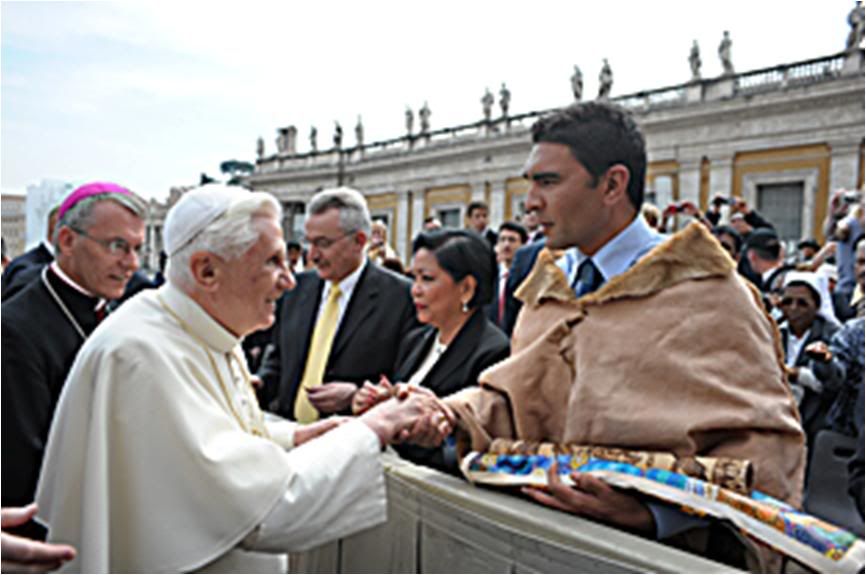
And Mark, a 28-year-old Australian, wearing a kangaroo pelt over his clothes, presented the Pope with a 'message stick', a traditional carved staff that the Australian aborigines use to transmit important messages or to communicate with high-ranking personages.
Mark's gift to the Pope however was inscribed with the logo of the Sydney WYD and figures of characteristic Australian animals. He said he wanted to thank the Pope again for coming to Australia.
Mark belongs to the Wiradjuri tribe and was at Barangaroo wharf with them to welcome Benedict XVI on July 17 last year.
"I am a teacher," he says, "and my students have great memories of the days they spent with their contemporaries from all over the world."
[Modificato da TERESA BENEDETTA 09/04/2009 01:14] |
 08/04/2009 22:04 08/04/2009 22:04 |
|
| | | OFFLINE | | Post: 17.090 | Registrato il: 28/08/2005
| Utente Gold | |
|
 Fr. Lombardi says
Fr. Lombardi says
the Pope isn't losing sleep
over the media assault
by Salvatore Izzo

VATICAN CITY, April 8 (Translated from AGI) - Fr. Federico Lombardi. Vatican press director, says the Pope not been particularly upset by the media tempest caused by his statement on condoms and AIDS when speaking to newsmen on his flight to Yaounde, Cameroon, last month.
He noted that to begin with, the Pope's statements were incompletely reported as well as misquoted.
He said that the Holy Father likened it to previous episodes when the Western media have chosen to dispute some aspect of Catholic doctrine or the Catholic position on social issues. [Of which Joseph Ratzinger was often at the receiving end for almost a quarter century!]
Fr. Lombardi said an interview with the Catholic news agency ZENIT that the virulence of political and media reactions does not condition what the Pope and his closest co-workers do. [I have checked all of Zenit'a language services but as of this writing, they have not yet posted the interview.]
"Those who have a negative opinion of the Pope and the Church", he said, "appear to have decided that we in the Church have no right to speak our thoughts, that we should be absent from the world, but the Pope has a very clear message of spirituality, of peace and reconciliation, that he seeks to convey to the world even when sometimes, the message may be a bit complicated."
Moreover, Lombardi added, "there may be immediate opposition to what the Pope says, but later on, when calm returns, there is time to verify his words, reflect on them, and at least, understand his true intention."
He said all this would be much easier if there was good faith on the part of the media, and if those who express themselves against the Pope and the Church first get their facts right.
"It's very clear that those who sincerely consider what the Pope says will understand him correctly, but if they don't even try to do that, then they will never understand," he continued.
Fr. Lombardi cited the Regensburg lecture in 2006 and its aftermath as an example of an apparent negative that ended up becoming positive. "It has brought to a better understanding between Muslims and Catholics," he said.
He also admitted that the polemics over the Pope's statement on condoms was aggravated because someone in the Secretariat of State tampered with the Pope's actual words with the effect of modifying their meaning.
He added quickly that as soon as the discrepancies were noted, 'the affected parts were immediately corrected and the Pope's original words were restored".
Fr. Lombardi was asked whether the Pope would still talk to newsmen on these flights, for instance, on the way to the Holy Land next month.
"I believe so," he said, noting that misunderstandings and similar problems are a usual hazard in communications, "so if one is fearful about such hazards, then we would all just stay home in the Vatican and not say anything".
He also said that media attacks were not unanimous and that the Pope does not lack for supporters in the pubic opinion who "appreciate the Pope's teaching and understand that what he says is very important for the world today."
He also denied that he was overburdened being charge of the Press Office, Vatican Radio and CTV.
"It's for my superiors to judge that," he said. "I know that rumors have been started about me to produce some effect. But as for me, to be in charge of the Press Office as well does not present a special problem."
[Modificato da TERESA BENEDETTA 09/04/2009 01:12] |
 09/04/2009 04:08 09/04/2009 04:08 |
|
| | | OFFLINE | | Post: 17.091 | Registrato il: 28/08/2005
| Utente Gold | |
|
 Normally, I would post an item like this in POPE-POURRI (where I will crosspost it, anyway), but it's a companion piece to the audience stories from today (3/9).
Normally, I would post an item like this in POPE-POURRI (where I will crosspost it, anyway), but it's a companion piece to the audience stories from today (3/9).
Also, it's very rare for veteran Vaticanistas to loosen up and write something like this - with fairly unfiltered impressions of the Pope they cover day in and day out - since they only report him in terms of what he says, as if color and 'human interest' observations had no place in news reporting... This item, from Paolo Rodari's blog, is still too terse and skimpy, of course, but better than nothing...
Random notes on
the General Audience today
by PAOLO RODARI
Translated from

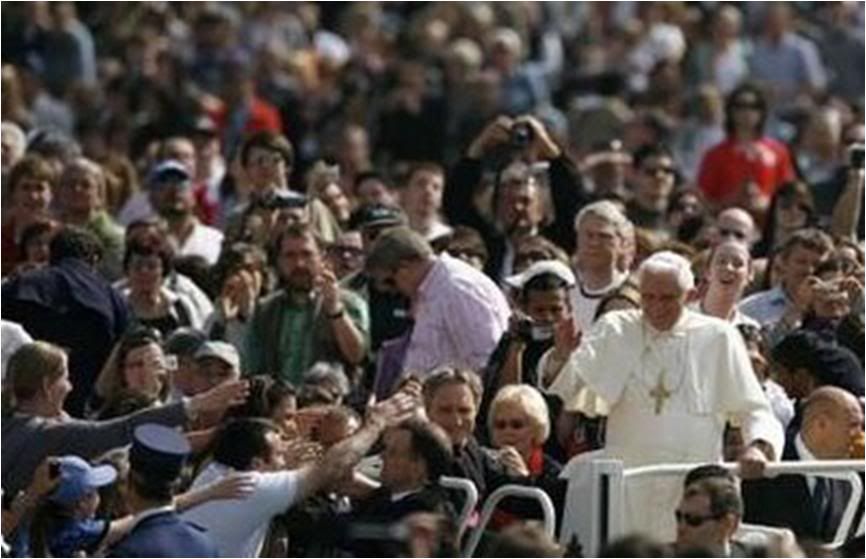
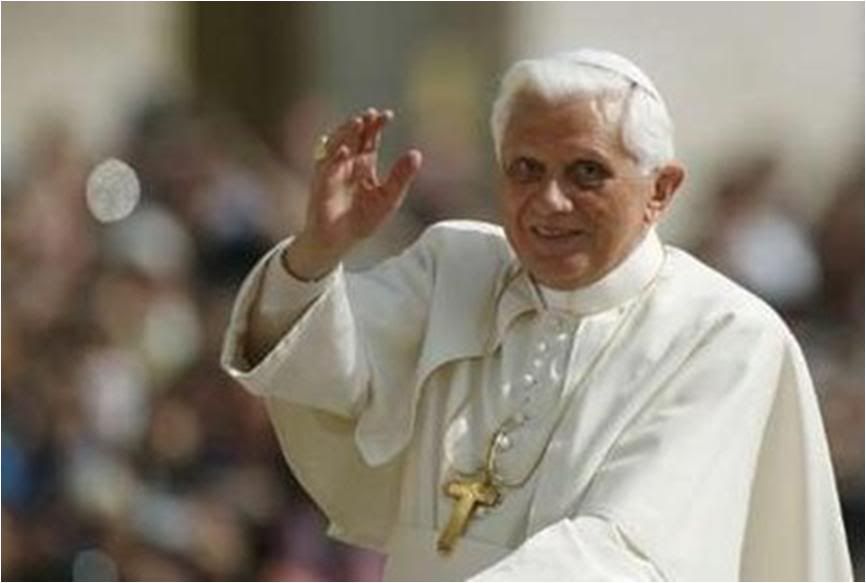
General Audience today at St. Peter's Square. The crowd has filled the square up to the two fountains on both sides of teh obelisk.
It's a sunny day, Benedict XVI's eyeglasses appear to have slightly tinted lenses. But not like Cardinal Bertone's whose lenses darken with the sun to the point of obscuring his eyes.
The Pope is reading from A4 sheets [the European standard page which is slightly narrower but slightly longer than 8.5x11 used elsewhere] the text of his catechesis dedicated to the passion of Christ. He cites Theodoretus of Syria...
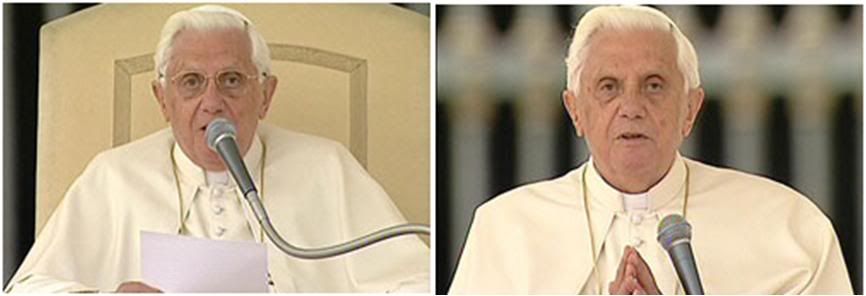
He raises his eyes frequently and when he does, he continues to speak without looking at the text, but without deviating from it, either. He seems to know what he has to say from memory....
Watching him 'recite' the catechesis [as opposed to merely reading it], I think of the time he must spend preparing his texts.
I am trying to observe his face closely. He doesn't seem tired at all. [But why should he? It's 10:30 in the morning!] And his smile, whenever the people applaud, is not forced at all. [Again, why should it? Smiling comes to him so naturally!]
His voice rings out, more than usual. As he speaks, he gestures lightly with his right hand - even this gesture is linear [????]
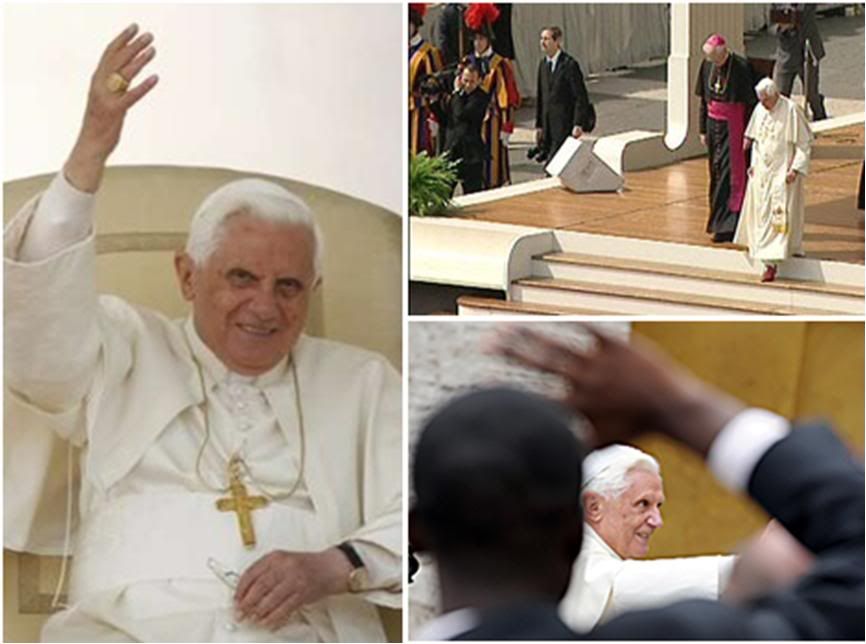
At the end, he has a greeting for everyone. He announces he will be visiting Abruzzo soon. He smiles as he raises his arms several times to acknowledge the crowd....
Then he leaves...The Paschal Triduum will be on us soon....The Arch of Bells frames the Pope's back as his Popemobile recedes within...
And Papa Ratzinger is immersed once more in mystery.
[Modificato da TERESA BENEDETTA 09/04/2009 04:14] |
 09/04/2009 14:15 09/04/2009 14:15 |
|
| | | OFFLINE | | Post: 17.093 | Registrato il: 28/08/2005
| Utente Gold | |
|

April 9
 St. Casilda of Toledo (11th cent)
St. Casilda of Toledo (11th cent)
Virgin (Spain)
OR today.
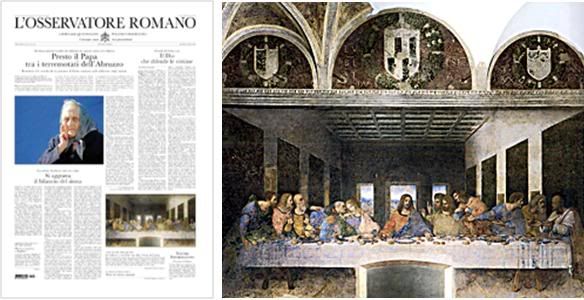
At the General Audience, the Pope recalls that the passion of Jesus
continues in the sufferings of man
'Pope to visit earthquake victims soon'
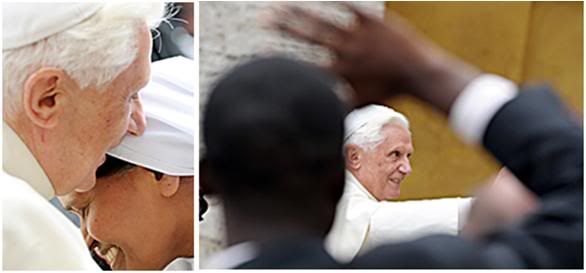
The other main Page 1 story is a wrap-up on developments regarding the earthquake aftermath in
the Abruzzo region. There is a commentary on Leonardo's 'Last supper', and an item on Obama's
surprise visit to Baghdad at the end of his European tour.
COMMUNIQUE FROM THE PRESS OFFICE OF THE HOLY SEE
Translated from

The Holy Father, in response to civilian and religious authorities in the Abruzzo region, has asked Cardinal Tarcisio Bertone to preside at the funeral Mass tomorrow in L"Aquila for the victims of the earthquake which struck the city and its surrounding areas.
Because of the exceptional circumstances, the Congregation for Divine Worship has allowed an indult to celebrate the funeral Mass although normally, no other liturgical rites are held on Good Friday except those 'in Passione Domini'.
As a sign of the Pope's personal closeness to those who are suffering because of the earthquake, his private secretary, Mons. Georg Gaenswein will also take part in the Mass.
 PAPAL LITURGIE3 FOR HOLY WEEK
PAPAL LITURGIE3 FOR HOLY WEEK
April 9
Maundy Thursday
HOLY MASS OF THE CHRISM
09:30 St. Peter's Basilica
The Holy Father will preside at the concelebrated Mass with all the cardinals, bishops and priests
present in Rome, as a sign of the close communion between the Pastor of teh Universal Church and
his brothers in the priesthood
PASCHAL TRIDUUM
April 9
Maundy Thursday
HOLY MASS OF THE LORD'S SUPPER
Capella Papale
17:30, Basilica of St. John Lateran
The Holy Father will preside at the concelebrated Mass and will perform the rite of 'washing the feet'
on 12 priests. At this time, a collection will be take up for the Catholic Community in the Gaza Strip.
The collection will be presented to the Holy Father at the Mass Offering.
After the Mass, the Blessed Sacrament will be taken to the Chapel of Reposition.
April 10
Good Friday
CELEBRATION OF THE PASSION OF THE LORD
Cappella Papale
17:00, St. Peter's Basilica
The Holy Father will preside at the Liturgy of the Word, Adoration of the Cross and the Communion rite.
VIA CRUCIS
21:15, Colosseum
The Holy Father will preside at the Stations of the Cross, after which he will address the faithful
and impart the Apostolic Blessing.
April 11-12
EASTER SUNDAY
EASTER VIGIL, April 11-12
Cappella Papale
21:00 St. Peter's Basilica
The Holy Father will bless the new flame in the atrium of the Basilica. After the processional entry
into the basilica with the Paschal candle and the chanting of the Exsultat, he will preside at the Liturgy
of the Word, the Baptismal Liturgy, and the Eucharistic Liturgy which will be concelebrated
with the cardinals present.
EASTER SUNDAY MASS
10:15 St. Peter's Square
The Holy Father will celebrate the Mass.
Afterwards, he will impart his blessing Urbi et Orbi from the central loggia of St. Peter's Basilica.
[Modificato da TERESA BENEDETTA 09/04/2009 15:12] |
 09/04/2009 14:51 09/04/2009 14:51 |
|
| | | OFFLINE | | Post: 17.094 | Registrato il: 28/08/2005
| Utente Gold | |
|
 MASS OF THE CHRISM
MASS OF THE CHRISM

At 9:30 today, Maundy Thursday, the Pope celebrated at St. Peter's Basilica, the Holy Mass of the Chrism. which is celebrated on this day in all cathedral churches [seats of bishops].
The Mass was concelebrated with cardinals and bishops present in Rome as well as the diocesan and religious priests of Rome.
During the rites, after the renewal of priestly vows, the Pope consecrated the oils for the catechumens and the sick, as well as the Chrism, which will be used by the diocese. in administering the sacraments for the coming year.
The Holy Father also consecrated oils and Chrism for the Archdiocese of L'Aquila, as he announced at the end of the Mass:
To our dear brother, Mons. Giuseppe Molinari, Archbishop of L'Aquila - who, because of the extremely grave results of the earthquake in his region, is unable to lead his priests for the celebration of the Chrismal Mass today - I wish to send these holy oils as a sign of profound communion and spiritual closeness.
May these holy oils accompany the period of rebirth and reconstruction, healing the wounded and sustaining hope.
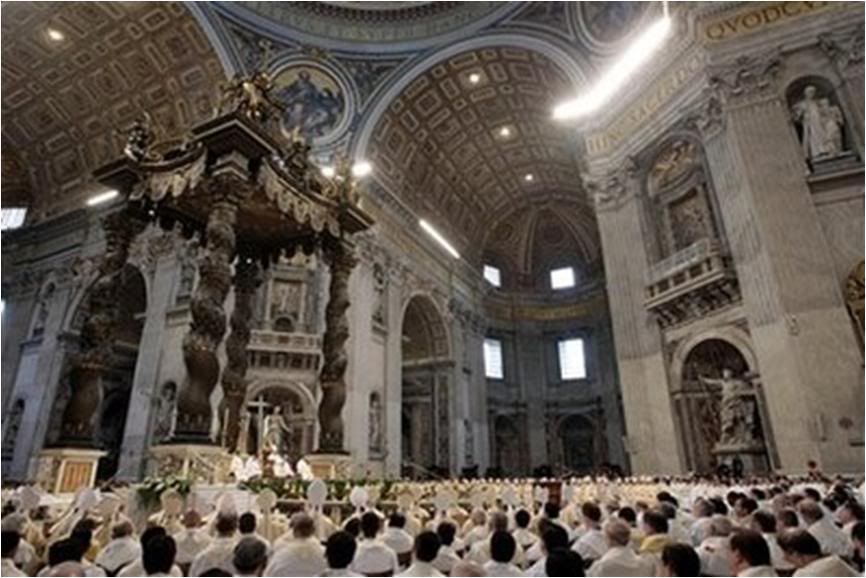
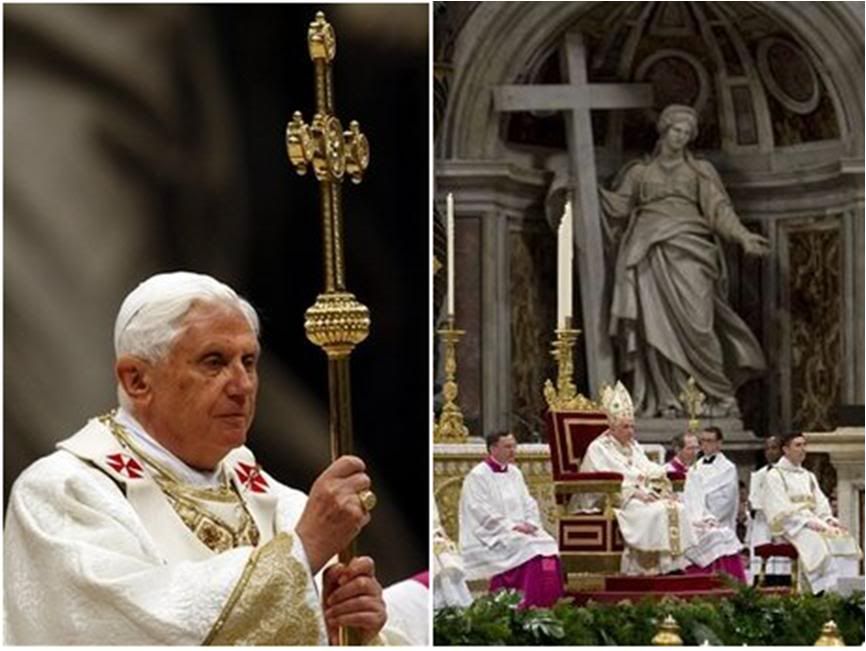
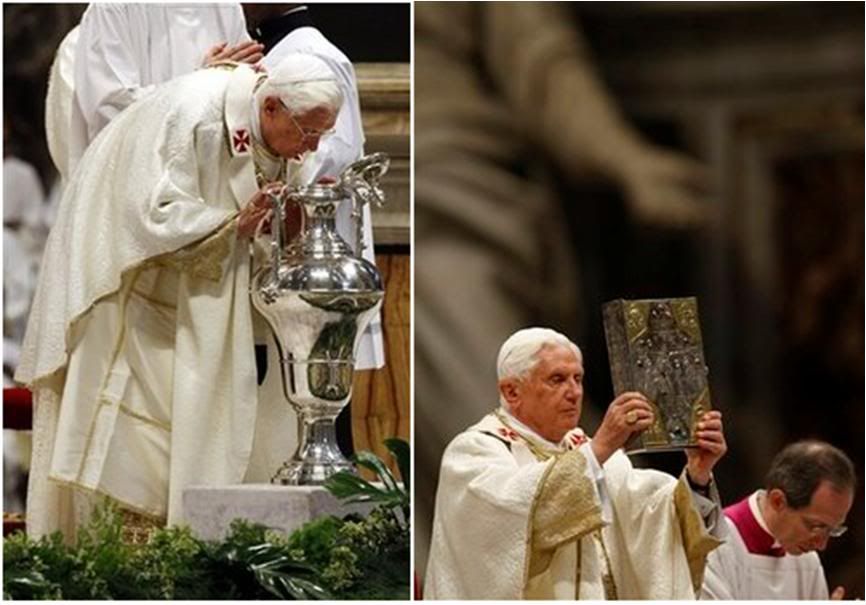 Vatican Radio's English service has provided this official translation of the Holy Father's homily, even as the regular Vatican bulletin has a note following its Italian text post that "The definitive official translations will be published later".
Vatican Radio's English service has provided this official translation of the Holy Father's homily, even as the regular Vatican bulletin has a note following its Italian text post that "The definitive official translations will be published later".
The Holy Father's words in this homily addressed to all priests in a Mass especially dedicated to all priests is even more powerful, in the light of defiant manifestations by many bishops and priests in the recent past.
He recalls a personal detail related to his own ordination that provided him with the leitmotif of TRUTH in his priestly ministry - it is also the theme of today's Gospel and this homily.
THE HOLY FATHER'S HOMILY
Dear Brothers and Sisters,
In the Upper Room, on the eve of his Passion, the Lord prayed for his disciples gathered about him. At the same time he looked ahead to the community of disciples of all centuries, “those who believe in me through their word” (Jn 17:20).
In his prayer for the disciples of all time, he saw us too, and he prayed for us. Let us listen to what he asks for the Twelve and for us gathered here:
“Sanctify them in the truth; your word is truth. As you sent me into the world, so I have sent them into the world. And for their sake I consecrate myself, so that they also may be consecrated in truth” (17:17ff.).
The Lord asks for our sanctification, sanctification in truth. And he sends us forth to carry on his own mission. But in this prayer there is one word which draws our attention, and appears difficult to understand.
Jesus says: “For their sake I consecrate myself”. What does this mean? Is Jesus not himself “the Holy One of God”, as Peter acknowledged at that decisive moment in Capharnaum (cf. Jn 6:69)? How can he now consecrate – sanctify – himself?
To understand this, we need first to clarify what the Bible means by the words “holy” and “consecrate – sanctify”. “Holy” – this word describes above all God’s own nature, his completely unique, divine, way of being, one which is his alone.
He alone is the true and authentic Holy One, in the original sense of the word. All other holiness derives from him, is a participation in his way of being.
He is purest Light, Truth and untainted Good. To consecrate something or someone means, therefore, to give that thing or person to God as his property, to take it out of the context of what is ours and to insert it in his milieu, so that it no longer belongs to our affairs, but is totally of God.
Consecration is thus a taking away from the world and a giving over to the living God. The thing or person no longer belongs to us, or even to itself, but is immersed in God.
Such a giving up of something in order to give it over to God, we also call a sacrifice: this thing will no longer be my property, but his property. In the Old Testament, the giving over of a person to God, his “sanctification”, is identified with priestly ordination, and this also defines the essence of the priesthood: it is a transfer of ownership, a being taken out of the world and given to God.
We can now see the two directions which belong to the process of sanctification-consecration. It is a departure from the milieux of worldly life – a “being set apart” for God.
But for this very reason it is not a segregation. Rather, being given over to God means being charged to represent others. The priest is removed from worldly bonds and given over to God, and precisely in this way, starting with God, he is available for others, for everyone.
When Jesus says: “I consecrate myself”, he makes himself both priest and victim. Bultmann was right to translate the phrase: “I consecrate myself” by “I sacrifice myself”.
Do we now see what happens when Jesus says: “I consecrate myself for them”? This is the priestly act by which Jesus – the Man Jesus, who is one with the Son of God – gives himself over to the Father for us.
It is the expression of the fact that he is both priest and victim. I consecrate myself – I sacrifice myself: this unfathomable word, which gives us a glimpse deep into the heart of Jesus Christ, should be the object of constantly renewed reflection. It contains the whole mystery of our redemption. It also contains the origins of the priesthood in the Church.
Only now can we fully understand the prayer which the Lord offered the Father for his disciples – for us. “Sanctify them in the truth”: this is the inclusion of the Apostles in the priesthood of Jesus Christ, the institution of his new priesthood for the community of the faithful of all times.
“Sanctify them in truth”: this is the true prayer of consecration for the Apostles. The Lord prays that God himself draw them towards him, into his holiness. He prays that God take them away from themselves to make them his own property, so that, starting from him, they can carry out the priestly ministry for the world.
This prayer of Jesus appears twice in slightly different forms. Both times we need to listen very carefully, in order to understand, even dimly the sublime reality that is about to be accomplished. “Sanctify them in the truth”.
Jesus adds: “Your word is truth”. The disciples are thus drawn deep within God by being immersed in the word of God. The word of God is, so to speak, the bath which purifies them, the creative power which transforms them into God’s own being.
So then, how do things stand in our own lives?
Are we truly pervaded by the word of God?
Is that word truly the nourishment we live by, even more than bread and the things of this world?
Do we really know that word? Do we love it?
Are we deeply engaged with this word to the point that it really leaves a mark on our lives and shapes our thinking?
Or is it rather the case that our thinking is constantly being shaped by all the things that others say and do?
Aren’t prevailing opinions the criterion by which we all too often measure ourselves?
Do we not perhaps remain, when all is said and done, mired in the superficiality in which people today are generally caught up?
Do we allow ourselves truly to be deeply purified by the word of God?
Friedrich Nietzsche scoffed at humility and obedience as the virtues of slaves, a source of repression. He replaced them with pride and man’s absolute freedom.
Of course there exist caricatures of a misguided humility and a mistaken submissiveness, which we do not want to imitate. But there also exists a destructive pride and a presumption which tear every community apart and result in violence.
Can we learn from Christ the correct humility which corresponds to the truth of our being, and the obedience which submits to truth, to the will of God?
“Sanctify them in the truth; your word is truth”: this word of inclusion in the priesthood lights up our lives and calls us to become ever anew disciples of that truth which is revealed in the word of God.
I believe that we can advance another step in the interpretation of these words. Did not Christ say of himself: “I am the truth” (cf. Jn 14:6)? Is he not himself the living Word of God, to which every other word refers?
Sanctify them in the truth – this means, then, in the deepest sense: make them one with me, Christ. Bind them to me. Draw them into me.
Indeed, when all is said and done, there is only one priest of the New Covenant, Jesus Christ himself. Consequently, the priesthood of the disciples can only be a participation in the priesthood of Jesus.
Our being priests is simply a new way of being united to Christ. In its substance, it has been bestowed on us for ever in the sacrament.
But this new seal imprinted upon our being can become for us a condemnation, if our lives do not develop by entering into the truth of the Sacrament.
The promises we renew today state in this regard that our will must be directed along this path: “Domino Iesu arctius coniungi et conformari, vobismetipsis abrenuntiantes”.
Being united to Christ calls for renunciation. It means not wanting to impose our own way and our own will, not desiring to become someone else, but abandoning ourselves to him, however and wherever he wants to use us.
As Saint Paul said: “It is no longer I who live, but Christ who lives in me” (Gal 2:20). In the words “I do”, spoken at our priestly ordination, we made this fundamental renunciation of our desire to be independent, “self-made”.
But day by day this great “yes” has to be lived out in the many little “yeses” and small sacrifices. This “yes” made up of tiny steps which together make up the great “yes”, can be lived out without bitterness and self-pity only if Christ is truly the center of our lives. If we enter into true closeness to him.
Then indeed we experience, amid sacrifices which can at first be painful, the growing joy of friendship with him, and all the small and sometimes great signs of his love, which he is constantly showing us.
“The one who loses himself, finds himself”. When we dare to lose ourselves for the Lord, we come to experience the truth of these words.
To be immersed in the Truth, in Christ – part of this process is prayer, in which we exercise our friendship with him and we come to know him: his way of being, of thinking, of acting.
Praying is a journey in personal communion with Christ, setting before him our daily life, our successes and failures, our struggles and our joys – in a word, it is to stand in front of him. But if this is not to become a form of self-contemplation, it is important that we constantly learn to pray by praying with the Church.
Celebrating the Eucharist means praying. We celebrate the Eucharist rightly if with our thoughts and our being we enter into the words which the Church sets before us. There we find the prayer of all generations, which accompany us along the way towards the Lord.
As priests, in the Eucharistic celebration we are those who by their prayer blaze a trail for the prayer of today’s Christians. If we are inwardly united to the words of prayer, if we let ourselves be guided and transformed by them, then the faithful will also enter into those words. And then all of us will become truly “one body, one spirit” in Christ.
To be immersed in God’s truth and thus in his holiness – for us this also means to acknowledge that the truth makes demands, to stand up, in matters great and small, to the lie which in so many different ways is present in the world; accepting the struggles associated with the truth, because its inmost joy is present within us.
Nor, when we talk about being sanctified in the truth, should we forget that in Jesus Christ truth and love are one. Being immersed in him means being immersed in his goodness, in true love.
True love does not come cheap, it can also prove quite costly. It resists evil in order to bring men true good. If we become one with Christ, we learn to recognize him precisely in the suffering, in the poor, in the little ones of this world; then we become people who serve, who recognize our brothers and sisters in him, and in them, we encounter him.
“Sanctify them in truth” – this is the first part of what Jesus says. But then he adds: “I consecrate myself, so that they also may be consecrated in truth” – that is, truly consecrated (Jn 17:19).
I think that this second part has a special meaning of its own. In the world’s religions there are many different ritual means of “sanctification”, of the consecration of a human person. Yet all these rites can remain something merely formal.
Christ asks for his disciples the true sanctification which transforms their being, their very selves; he asks that it not remain a ritual formality, but that it make them truly the “property” of the God of holiness.
We could even say that Christ prayed on behalf of us for that sacrament which touches us in the depths of our being. But he also prayed that this interior transformation might be translated day by day in our lives; that in our everyday routine and our concrete daily lives we might be truly pervaded by the light of God.
On the eve of my priestly ordination, fifty-eight years ago, I opened the Sacred Scripture, because I wanted to receive once more a word from the Lord for that day and for my future journey as a priest.
My gaze fell on this passage: “Sanctify them in the truth; your word is truth”. Then I realized: the Lord is speaking about me, and he is speaking to me. This very same thing will be accomplished tomorrow in me.
When all is said and done, we are not consecrated by rites, even though rites are necessary. The bath in which the Lord immerses us is himself – the Truth in person.
Priestly ordination means: being immersed in him, immersed in the Truth. I belong in a new way to him and thus to others, “that his Kingdom may come”.
Dear friends, in this hour of the renewal of promises, we want to pray to the Lord to make us men of truth, men of love, men of God. Let us implore him to draw us ever anew into himself, so that we may become truly priests of the New Covenant. Amen.
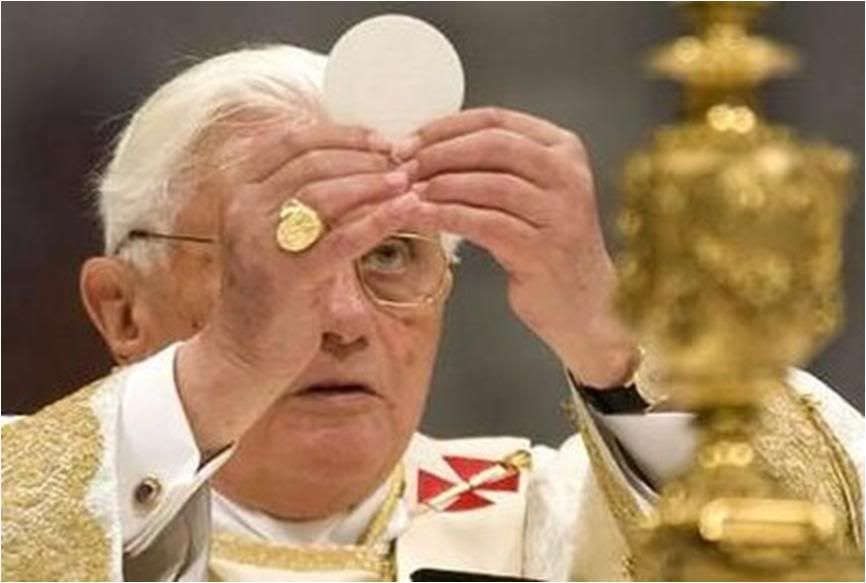

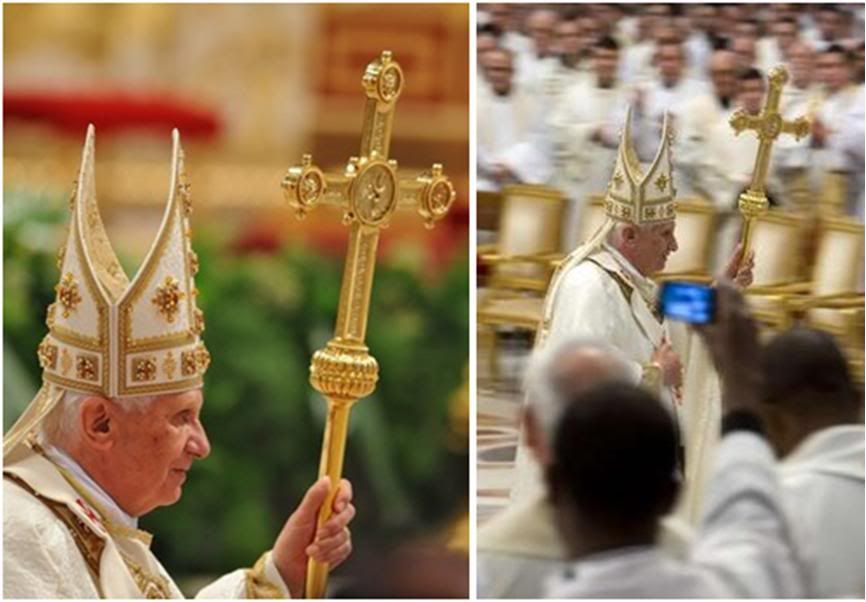

4/10/09
For the record, L'Osservatore Romano today lists the cardinals and other Vatican officials who concelebrated the Chrismal Mass with the Holy Father:
Cardinals Angelo Sodano, dean of the College of Cardinals; Tarcisio Bertone, Giovanni Battista Re, José Saraiva Martins, Jozef Tomko, Eduardo Martínez Somalo, Achille Silvestrini, Edmund Casimir Szoka, José T. Sánchez, Camillo Ruini, Darío Castrillón Hoyos, James Francis Stafford, Salvatore De Giorgi, Giovanni Cheli, Ivan Dias, Cláudio Hummes, Ennio Antonelli, Agostino Cacciavillan, Sergio Sebastiani, Jorge María Mejía, Francesco Marchisano, Julián Herranz, Javier Lozano Barragán, Georges Marie Martin Cottier, Franc Rodé, Agostino Vallini, Leonardo Sandri, John Patrick Foley, Giovanni Lajolo, Angelo Comastri, Stanislaw Rylko, Giovanni Coppa, and Urbano Navarrete.
Among the other prelates:
Archbishops Fernando Filoni, deputy Secretary of State; Carlo Maria Viganò, representing the apostolic nuncios; and James Michael harvey, Prefect of the Pontifical Household;
Bishops Gabriele Caccia, senior counsellor in the Secretariat of State; Pietro Parolin, undersecretary for relations with states; Fortunatus Nwachukwu, chief of protocol; Paolo De Nicolò, regent of the Pontifical Household; as well as Monsignors Georg Gänswein and Alfred Xuereb, private secretaries to the Holy Father.
[Modificato da TERESA BENEDETTA 11/04/2009 03:55] |
 09/04/2009 15:23 09/04/2009 15:23 |
|
| | | OFFLINE | Post: 105 | Registrato il: 22/06/2005
| Utente Junior | |
|
video gifts from general audience 5 april
![[SM=g27817]](https://im0.freeforumzone.it/up/0/17/28150804.gif)
*********************************************************************
RUSSI...
SEI SEMPRE UN TESORO.... MILLE GRAZIE!!!!
Teresa
[Modificato da TERESA BENEDETTA 09/04/2009 15:29] E' bello il Papa!
www.benedictxvi.tv - video papale
www.benediktxvi.ru - Ratzinger-Inform agency |
 09/04/2009 16:51 09/04/2009 16:51 |
|
| | | OFFLINE | | Post: 17.095 | Registrato il: 28/08/2005
| Utente Gold | |
|
 Thanks to Lella
Thanks to Lella

for this item.
POPE ADDS BRESCIA
TO PASTORAL VISITS
IN ITALY THIS YEAR

At the end of his Chrismal Mass homily today, the Bishop of Brescia (in northern Italy), Mons. Luciano Monaro, made this announcement (translated here) which also appears on the site of the Diocese of Brescia:
I am happy to be able to officially make an announcement that is cause for joy among our priests and for the entire church of Brescia.
The Pope will come to visit us on November 8. Of course, the immediate reason is the 30th anniversary of the death of Paul VI. [A belated one, since the 30th anniversary was last year. on August 6.]
Papa Ratzinger, as you know, was crated a cardinal y Paul VI, and has always had great esteem and affection for our Brescian Pope.
The program will be defined by the Prefecture of the Papal Household and will be published in the next few weeks, but the significance of this visit is very clear. It will be a day of intense prayer and communion....
Earlier announced pastoral visits in Italy this year were to Cassino, San Giovanni Rotondo (Padre Pio shrine), and Viterbo-Bagnoregio - all of them fairly close to Rome. Brescia, on the other hand, is 60 miles east of Milan.
The Pope will also be making an unforeseen pastoral visit to L'Aquila probably next week because of the recent earthquake.
In its 4/10/09 issue

has a brief item that does give additional information:
Benedict XVI will visit Brescia on November 8 to inaugurate the new headequarters of the Istituto Paolo VI in Concesio.
The announcement of the visit was given by the Bishop of Brescia, Luciano Monari at teh Chrismal Mass yesterday, Maundy Thursday.
After inaugurating the center, Benwedict XVI will lead the midday Angelus and in the afternoon, will say Mass for the entire diocesan community.
[Modificato da TERESA BENEDETTA 10/04/2009 02:52] |
 09/04/2009 19:17 09/04/2009 19:17 |
|
| | | OFFLINE | | Post: 17.096 | Registrato il: 28/08/2005
| Utente Gold | |
|
 MASS OF THE LORD'S SUPPER
MASS OF THE LORD'S SUPPER
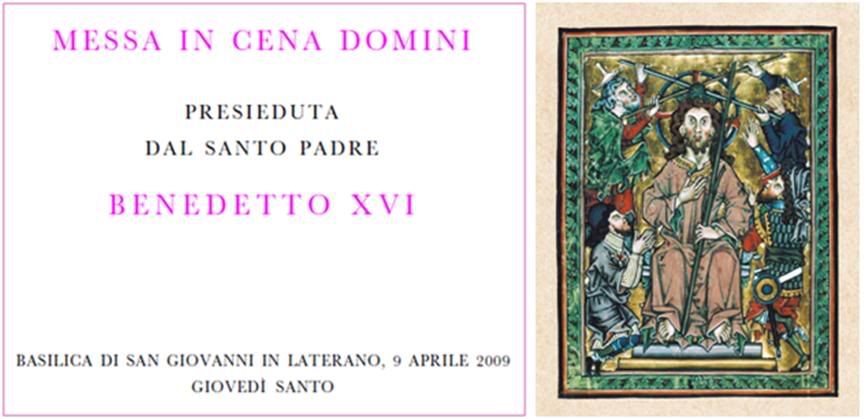 Libretto illustration: Christus Dominus, from the Cistercian Psaltery, ca. 1240, Municipal Library of Besancon, France.
Libretto illustration: Christus Dominus, from the Cistercian Psaltery, ca. 1240, Municipal Library of Besancon, France.

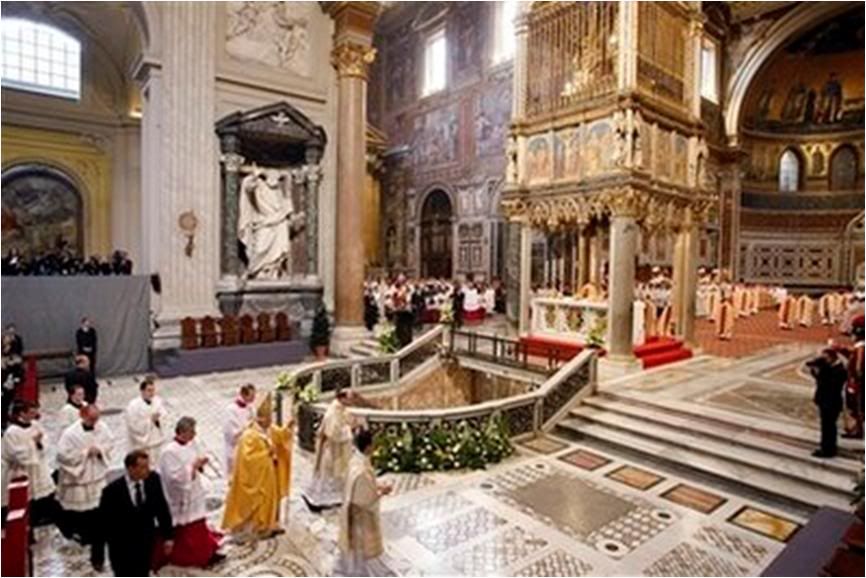
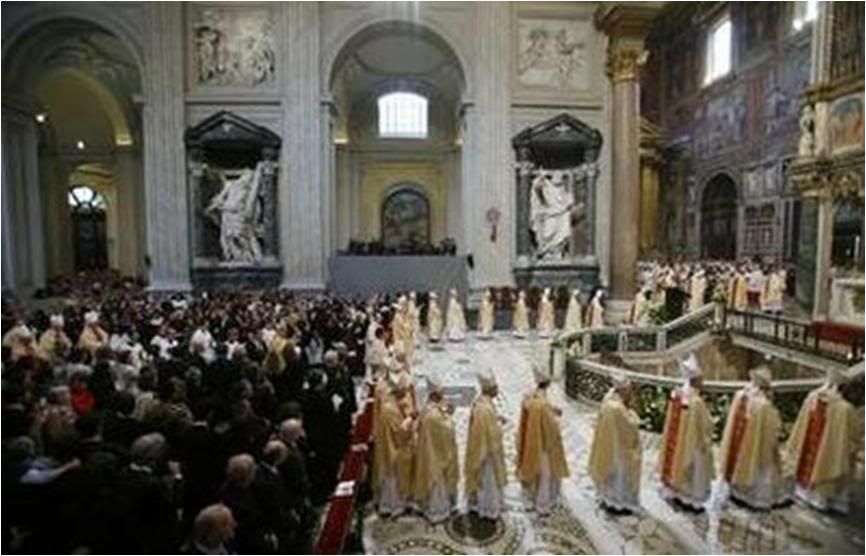
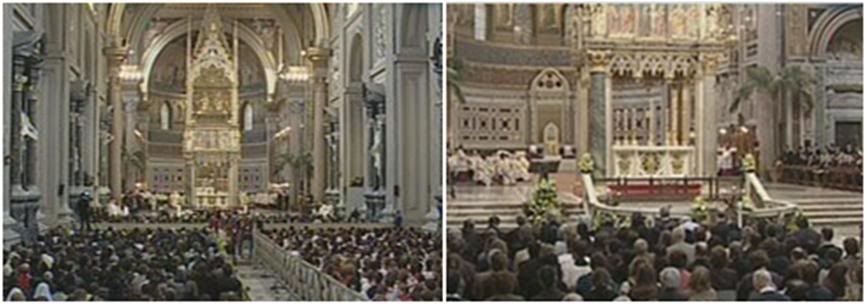
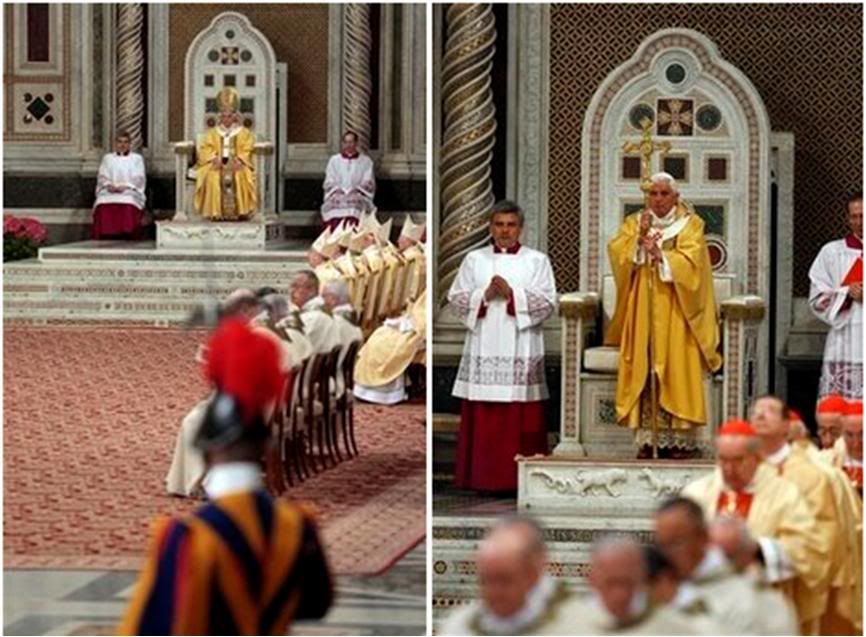 Once again, courtesy of Vatican Radio's English service, the official translation of the Holy Faher's homily, posted as soon as he had delivered it. (The Mass is still going on as I am posting this).
Once again, courtesy of Vatican Radio's English service, the official translation of the Holy Faher's homily, posted as soon as he had delivered it. (The Mass is still going on as I am posting this).
And once again, the Holy Father accomplishes a magnificent homily that is also a model catechesis on the Holy Sacrifice of the Mass and the Eucharist, and what the Lord's actions at the Last Supper should signify to Christians, and particularly, to priests at every moment of their priestly life:
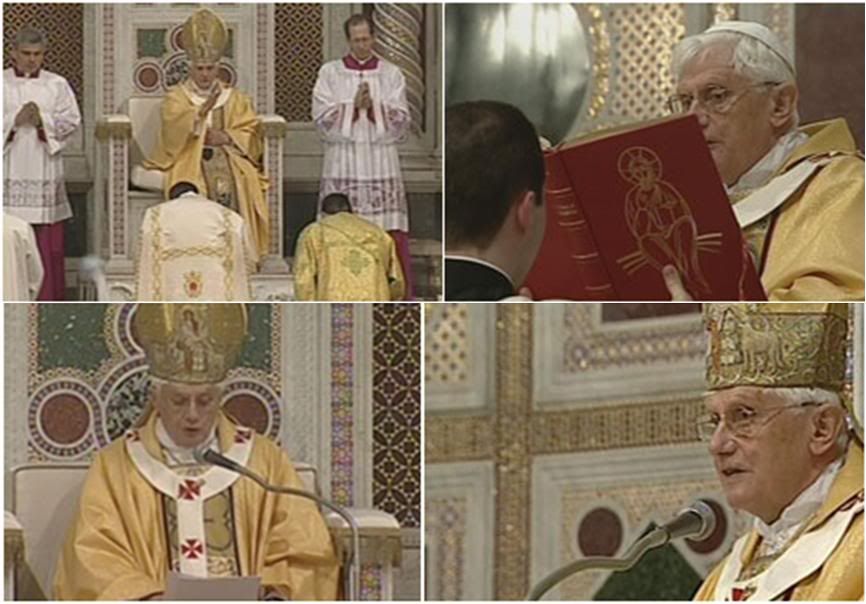
THE HOLY FATHER'S HOMILY
Dear Brothers and Sisters,
Qui, pridie quam pro nostra omniumque salute pateretur, hoc est hodie, accepit panem: these words we shall pray today in the Canon of the Mass.
“Hoc est hodie” – the Liturgy of Holy Thursday places the word “today” into the text of the prayer, thereby emphasizing the particular dignity of this day.
It was “today” that He did this: he gave himself to us for ever in the Sacrament of his Body and Blood.
This “today” is first and foremost the memorial of that first Paschal event. Yet it is something more.
With the Canon, we enter into this “today”. Our today comes into contact with his today. He does this now.
With the word “today”, the Church’s Liturgy wants us to give great inner attention to the mystery of this day, to the words in which it is expressed.
We therefore seek to listen in a new way to the institution narrative, in the form in which the Church has formulated it, on the basis of Scripture and in contemplation of the Lord himself.
The first thing to strike us is that the institution narrative is not an independent phrase, but it starts with a relative pronoun: qui pridie. This “qui” connects the entire narrative to the preceding section of the prayer, “let it become for us the body and blood of Jesus Christ, your only Son, our Lord.”
In this way, the institution narrative is linked to the preceding prayer, to the entire Canon, and it too becomes a prayer. By no means is it merely an interpolated narrative, nor is it a case of an authoritative self-standing text that actually interrupts the prayer.
It is a prayer. And only in the course of the prayer is the priestly act of consecration accomplished, which becomes transformation, transubstantiation of our gifts of bread and wine into the Body and Blood of Christ.
As she prays at this central moment, the Church is fully in tune with the event that took place in the Upper Room, when Jesus’S action is described in the words: “gratias agens benedixit – he gave you thanks and praise”.
In this expression, the Roman liturgy has made two words out of the one Hebrew word berakha, which is rendered in Greek with the two terms, eucharistía and eulogía.
The Lord gives thanks. When we thank, we acknowledge that a certain thing is a gift that has come from another. The Lord gives thanks, and in so doing gives back to God the bread, “fruit of the earth and work of human hands”, so as to receive it anew from him.
Thanksgiving becomes blessing. The offering that we have placed in God’s hands returns from him blessed and transformed. The Roman liturgy rightly interprets our praying at this sacred moment by means of the words: “through him, we ask you to accept and bless these gifts we offer you in sacrifice”. All this lies hidden within the word “eucharistia”.
There is another aspect of the institution narrative cited in the Roman Canon on which we should reflect this evening. The praying Church gazes upon the hands and eyes of the Lord.
It is as if she wants to observe him, to perceive the form of his praying and acting in that remarkable hour, she wants to encounter the figure of Jesus even, as it were, through the senses.
“He took bread in his sacred hands …” Let us look at those hands with which he healed men and women; the hands with which he blessed babies; the hands that he laid upon men; the hands that were nailed to the Cross and that forever bear the stigmata as signs of his readiness to die for love.
Now we are commissioned to do what he did: to take bread in our hands so that through the Eucharistic Prayer it will be transformed. At our priestly ordination, our hands were anointed, so that they could become hands of blessing.
Let us pray to the Lord that our hands will serve more and more to bring salvation, to bring blessing, to make his goodness present!
From the introduction to the Priestly Prayer of Jesus (cf. Jn 17:1), the Canon takes these words: “Looking up to heaven, to you his almighty Father …” The Lord teaches us to raise our eyes, and especially our hearts. He teaches us to fix our gaze upwards, detaching it from the things of this world, to direct ourselves in prayer towards God and thus to raise ourselves.
In a hymn from the Liturgy of the Hours, we ask the Lord to guard our eyes, so that they do not take in or cause to enter within us “vanitates” – vanities, nothings, that which is merely appearance.
Let us pray that no evil will enter through our eyes, falsifying and tainting our very being. But we want to pray above all for eyes that see whatever is true, radiant and good; so that they become capable of seeing God’s presence in the world.
Let us pray that we will look upon the world with eyes of love, with the eyes of Jesus, recognizing our brothers and sisters who need our help, who are awaiting our word and our action.
Having given thanks and praise, the Lord then breaks the bread and gives it to the disciples.
Breaking the bread is the act of the father of the family who looks after his children and gives them what they need for life. But it is also the act of hospitality with which the stranger, the guest, is received within the family and is given a share in its life.
Dividing (dividere), sharing (condividere) brings about unity. Through sharing, communion is created. In the broken bread, the Lord distributes himself.
The gesture of breaking also alludes mysteriously to his death, to the love that extends even to death. He distributes himself, the true “bread for the life of the world” (cf. Jn 6:51).
The nourishment that man needs in his deepest self is communion with God himself. Giving thanks and praise, Jesus transforms the bread, he no longer gives earthly bread, but communion with himself.
This transformation, though, seeks to be the start of the transformation of the world – into a world of resurrection, a world of God. Yes, it is about transformation – of the new man and the new world that find their origin in the bread that is consecrated, transformed, transubstantiated.
We said that breaking the bread is an act of communion, an act of uniting through sharing. Thus, in the act itself, the intimate nature of the Eucharist is already indicated: it is agape, it is love made corporeal. In the word “agape”, the meanings of Eucharist and love intertwine.
In Jesus’S act of breaking the bread, the love that is shared has attained its most radical form: Jesus allows himself to be broken as living bread.
In the bread that is distributed, we recognize the mystery of the grain of wheat that dies, and so bears fruit. We recognize the new multiplication of the loaves, which derives from the dying of the grain of wheat and will continue until the end of the world.
At the same time, we see that the Eucharist can never be just a liturgical action. It is complete only if the liturgical agape then becomes love in daily life.
In Christian worship, the two things become one – experiencing the Lord’s love in the act of worship and fostering love for one’s neighbour. At this hour, we ask the Lord for the grace to learn to live the mystery of the Eucharist ever more deeply, in such a way that the transformation of the world can begin to take place.
After the bread, Jesus takes the chalice of wine. The Roman Canon describes the chalice which the Lord gives to his disciples as “praeclarus calix” (the glorious cup), thereby alluding to Psalm 23 [22], the Psalm which speaks of God as the Good Shepherd, the strong Shepherd.
There we read these words: “You have prepared a banquet for me in the sight of my foes … My cup is overflowing” – calix praeclarus.
The Roman Canon interprets this passage from the Psalm as a prophecy that is fulfilled in the Eucharist: yes, the Lord does indeed prepare a banquet for us in the midst of the threats of this world, and he gives us the glorious chalice – the chalice of great joy, of the true feast, for which we all long – the chalice filled with the wine of his love.
The chalice signifies the wedding-feast: now the “hour” has come to which the wedding-feast of Cana had mysteriously alluded. Yes indeed, the Eucharist is more than a meal, it is a wedding-feast. And this wedding is rooted in God’s gift of himself even to death.
In the words of Jesus at the Last Supper and in the Church’s Canon, the solemn mystery of the wedding is concealed under the expression “novum Testamentum”. This chalice is the new Testament – “the new Covenant in my blood”, as Saint Paul presents the words of Jesus over the chalice in today’s second reading (1 Cor 11:25). The Roman Canon adds: “of the new and everlasting covenant”, in order to express the indissolubility of God’s nuptial bond with humanity.
The reason why older translations of the Bible do not say Covenant, but Testament, lies in the fact that this is no mere contract between two parties on the same level, but it brings into play the infinite distance between God and man.
What we call the new and the ancient Covenant is not an agreement between two equal parties, but simply the gift of God who bequeaths to us his love – himself. Certainly, through this gift of his love, he transcends all distance and makes us truly his “partners” – the nuptial mystery of love is accomplished.
In order to understand profoundly what is taking place here, we must pay even greater attention to the words of the Bible and their original meaning.
Scholars tell us that in those ancient times of which the histories of Israel’s forefathers speak, to “ratify a Covenant” means “to enter with others into a bond based on blood or to welcome the other into one’s own covenant fellowship and thus to enter into a communion of mutual rights and obligations”.
In this way, a real, if non-material form of consanguinity is established. The partners become in some way “brothers of the same flesh and the same bones”. The covenant brings about a fellowship that means peace (cf. ThWNT II, 105-137).
Can we now form at least an idea of what happened at the hour of the Last Supper, and what has been renewed ever since, whenever we celebrate the Eucharist? God, the living God, establishes a communion of peace with us, or to put it more strongly, he creates “consanguinity” between himself and us.
Through the incarnation of Jesus, through the outpouring of his blood, we have been drawn into an utterly real consanguinity with Jesus and thus with God himself.
The blood of Jesus is his love, in which divine life and human life have become one. Let us pray to the Lord, that we may come to understand ever more deeply the greatness of this mystery.
Let us pray that in our innermost selves its transforming power will increase, so that we truly acquire consanguinity with Jesus, so that we are filled with his peace and grow in communion with one another.
Now, however, a further question arises.
In the Upper Room, Christ gives his Body and Blood to the disciples, that is, he gives himself in the totality of his person. But can he do so? He is still physically present in their midst, he is standing in front of them!
The answer is: at that hour, Jesus fulfils what he had previously proclaimed in the Good Shepherd discourse: “No one takes my life from me: I lay it down of my own accord. I have power to lay it down and I have power to take it again …” (Jn 10:18). No one can take his life from him: he lays it down by his own free decision.
At that hour, he anticipates the crucifixion and resurrection. What is later to be fulfilled, as it were, physically in him, he already accomplishes in anticipation, in the freedom of his love. He gives his life and he takes it again in the resurrection, so as to be able to share it for ever.
Lord, today you give us your life, you give us yourself. Enter deeply within us with your love. Make us live in your “today”. Make us instruments of your peace! Amen.

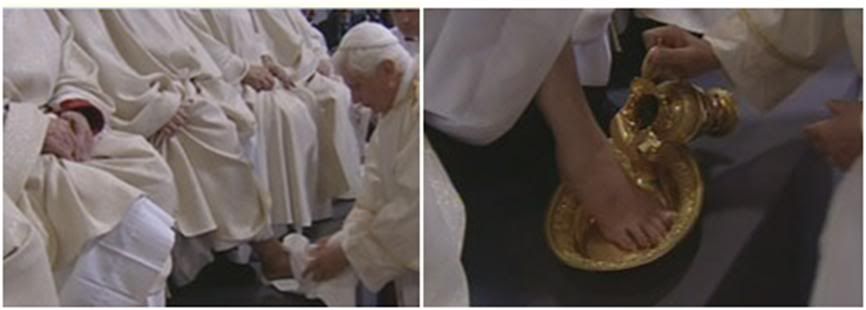

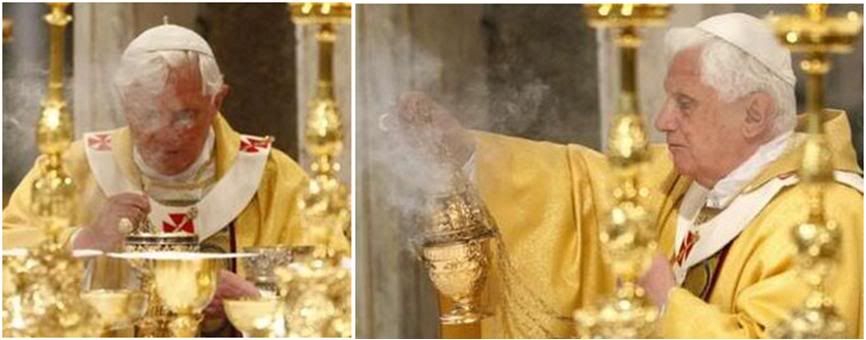
 Right photo below: Procession transferring the Blessed Sacrament to the Altar of Reposition.
Right photo below: Procession transferring the Blessed Sacrament to the Altar of Reposition.
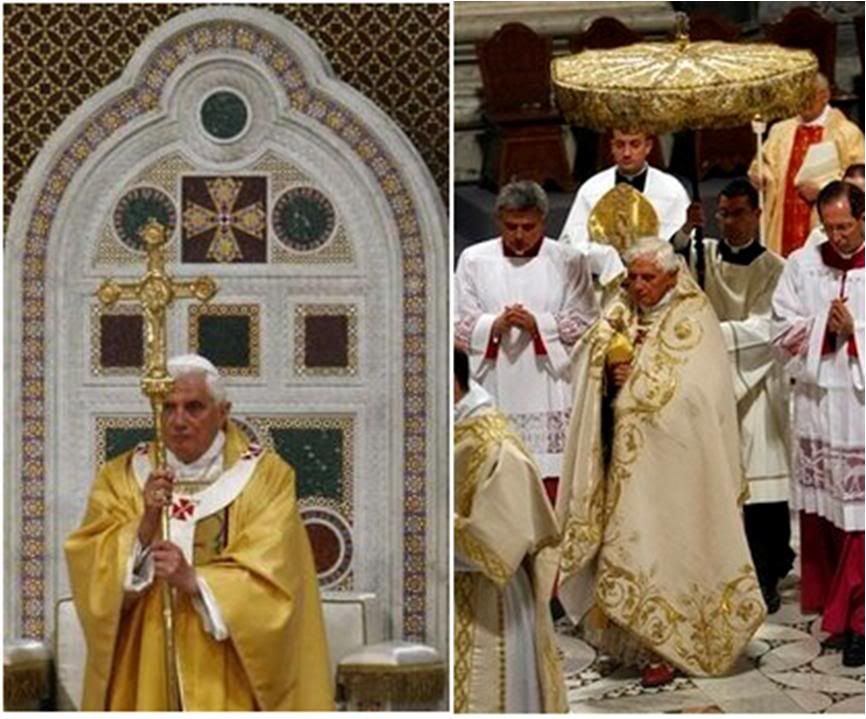
[Modificato da TERESA BENEDETTA 11/04/2009 03:57] |
 10/04/2009 03:59 10/04/2009 03:59 |
|
| | | OFFLINE | Post: 3.765 | Registrato il: 23/11/2005
| Utente Master | |
|
Palestinian Christians Look Toward the Papal Visit
By Deal W. Hudson, Ph.D.
4/10/2009
Inside Catholic
This is the moment when Christians living under the occupation need a word of support from the leader of the Church.
JERUSALEM (Inside Catholic) - Palestinian Christians are wondering aloud whether the upcoming visit of Pope Benedict XVI to the Holy Land will bring greater media attention to their dwindling numbers. They fear that, at the top, the pope's agenda will be dominated by his continuing effort to smooth the ruffled feathers of Muslims (after his 2006 Regensburg speech) and Jews (following the recent trouble over the anti-Semitism of Bishop Richard Williamson of the Society of St. Pius X).
Building better relations with Israel, the international Jewish community, and Muslims is the "story line already written by the media for the papal visit," one Vatican observer told me.But the real motive behind the visit, according to the same observer with close ties to the Vatican, is the pope's desire to make a "personal pilgrimage" to the holy sites. His message will be a message to the Church, he continued, and should not be expected to target "specific problems" on the ground.
It's impossible, however, for a papal visit to Israel, the West Bank, and Jordan not to be scrutinized from every possible angle. Everyone in the region, and many around the world, will be listening for any possible comment on the ongoing occupation by Israel of the West Bank and its impact on the historic Christian communities of places like Bethlehem, Nazareth, Beit Jala, and Beit Sahour.
Opinions differ on the primary cause for the departure of Christians out of the West Bank and East Jerusalem. Some point to the rigors of the occupation, especially restrictions on the freedom of movement imposed by checkpoints and security walls. Others talk about the mounting tensions between Christians and Muslims in towns like Bethlehem, where their families once lived side by side without rancor as far back as anyone can remember. Indeed, on this, my fourth trip to the Holy Land in six years, I have heard more about Muslim hostility to Christians than ever before.
My own observation is that, when people are locked in a prison with little hope of ever getting out, they turn their gaze inward. Divisions that once didn't matter become very relevant. Similarly, when two peoples live together under an occupation without the freedom of movement, they start finding more fault with each other.
Bernard Sabella, a professor at Bethlehem University and a Christian member of the Palestinian legislature, offers another explanation for the exodus. "The main reason is unemployment. If the young people can't find work, they leave, it's that simple."
Sabella's research has found that in good economic years, about 200 to 300 Palestinian Christians between the ages of 25 and 30 leave the West Bank and East Jerusalem. In bad economic times, the numbers shoot up to between 900 and 1,000 a year. With only 50,000 Christians in those areas, the net result is a steadily shrinking community whose recovery is dependent on the return of a robust economy. Sabella adds, "How can you have a strong economy with plenty of jobs for young people out of college when they cannot, for example, even leave the city of Bethlehem but only rarely?"
Without freedom of movement, Sabella argues, the economy cannot grow, more and more Palestinians will depend on foreign aid for subsistence, and young Christians will choose to leave in search of better lives. Sabella's analysis, although beginning with the problem of unemployment, points back to the impact of the Israeli occupations and, particularly, the more stringent measures taken since theintifada that began in 2000.
If Benedict addresses the root causes for the declining Christian presence in the Holy Land, he will very likely offend both Israelis and Muslims, the very parties with whom he might have hoped to strengthen ties. Yet this is the moment when Christians living under the occupation need a word of support from the leader of the Church. After the Gaza campaign and the election of Benjamin Netanyahu as prime minister, they have little hope that Israel will pursue a two-state solution. They also put little faith in the promises of the Obama administration -- not because of Obama himself, but because of their disappointments in previous U.S. presidents.
One frustrated Christian put it to me bluntly: "The pope must do something for his Christians here in the Holy Land, or there will be none of us here in 20 years." This father of two young children, living in Bethlehem and struggling to keep his family on the West Bank, is considering the option of immigrating for the first time in his life. His attitude, I am told, is becoming widespread among educated Palestinian Christians.
Benedict has already shown himself capable of rising to the occasion to overcome controversy, as on his trip to the United States a year ago when he defused the criticism awaiting him about the priest sex scandal. His proactive comments to the media on the flight to Washington, D.C., let the air out of the balloon of invective that was ready to burst upon his arrival.
The Holy Father may well find a way to navigate through the more rocky shores of Israeli-Palestinian conflict, and the Palestinian Christians caught in the middle.
-------
Deal W. Hudson is the director of InsideCatholic.com and the author of Onward, Christian Soldiers: The Growing Political Power of Catholics and Evangelicals in the United States (Simon and Schuster).
**********************************************************************
HOW ABOUT A MORE REALISTIC
AND PRAGMATIC VIEW????
While we can all understand and sympathize with the frustration of the Palestinian Christians, I think it is most unrealistic - and unfair - of them to expect the Pope to be able to do anything about the poitical situation that is at the root of the socio-economic problem that is driving away Christians from the places like Iraq, Lebanon and the Palestinian territories.
And very wrong of the Western media to feed their unrealistic expectations with agenda articles like this, no matter how well-meaning.
Fourteen years and two Popes - and still, the Vatican has been unable to finalize a status agreement for the Catholic Church in Israel! And we have just been warned that the Pope's coming visit is not bringing the question to any conclusion soon.
If something that should not be a problem - the Israeli Parliament passed a 'general' agreement 14 years ago, cynically leaving all the devils loose in the details - has proven so intransigent, what makes the Palestinian Christians think the Pope will be able to do something about their infintely more complicated problems that decades of undoubtedly well-meaning work by the great political powers have failed to resolve?
I'm sure every conscientious Christian prays constantly for 'peace in teh Middle East and a good life for all its peoples'.
But he must also ask himself over and over why the land where God walked the earth has been the world's bloodiest battleground driven by sheer hatred for much of its history. The more so if the Christian happens to live in the Middle East today.
And the best answer one can give is that God's ways are unfathomable. One must live with the situation given each of us by Providence which does not necessarily play favorites. Different trials are imposed on each of us, and in different degrees. And we must each respond to these trials as best we can.
The Pope and the Church will continue to do what they have been able to do - give moral support and prayers, along with whatver material support it is able to do through Caritas and other Church-based or Church-associated institutions.
But it is totally unrealistic to expect that the Church can ensure the material terrestrial future of Christians in the Midcle East.
One frustrated Christian put it to me bluntly: "The Pope must do something for his Christians here in the Holy Land, or there will be none of us here in 20 years."
This father of two young children, living in Bethlehem and struggling to keep his family on the West Bank, is considering the option of immigrating for the first time in his life. His attitude, I am told, is becoming widespread among educated Palestinian Christians.
If immigration is the better option, then why not? Iraqi Christians have been forced to do it in the past 6 years, and some of them are starting to come back now. It's a decision parents have to make with the good of their children in mind, and for which they have to temporarily renounce sentiments of patriotism and attachment to one's native land.
But history has shown that in situations like these, there will always be a chosen few who will remain and persevere and survive - placeholders for those who are constrained to leave, as well as, perhaps, the stuff of saints.
The Pope has always spoken of this trip as a pilgrimage to pray for peace. More than anyone else, he knows none of us can read God's mind. And that it is part of man's lot to ask unanswerable questions.
Why does a child get cancer? Why did the Holocaust happen? Why is the Middle East so torn apart by hatreds? And if the last two, for instance, are traceable to political and ideological reasons, their undelrying question is: why is man capable of such evil? But that is why we all need salvation. And why ultimately, we only have our faith to live by.
TERESA
[Modificato da TERESA BENEDETTA 10/04/2009 06:41] |
 10/04/2009 06:50 10/04/2009 06:50 |
|
| | | OFFLINE | | Post: 17.098 | Registrato il: 28/08/2005
| Utente Gold | |
|
 Pope Benedict to find Holy Land
Pope Benedict to find Holy Land
changed since predecessor's visit
By Judith Sudilovsky

JERUSALEM. April 9 (CNS) - Pope Benedict XVI will encounter a Holy Land that has changed greatly since Pope John Paul II visited in 2000.
Pope John Paul arrived in Israel and the Palestinian territories when, despite stumbling blocks in the peace process, the Jubilee Year celebrations seemed to buoy the Holy Land with a booming tourism industry.
But Pope Benedict will visit amid continued Israeli-Palestinian tensions -- months after a controversial Israeli invasion of Gaza and during continuing Palestinian rocket attacks against southern Israeli towns.
On his visit to Bethlehem, West Bank, Pope John Paul was received by a united Palestinian Authority, led by longtime Palestinian leader Yasser Arafat.
In May Palestinian President Mahmoud Abbas, who is struggling to unite the Palestinian factions following a 2007 split with the Islamic fundamentalist political party and militia Hamas, will welcome Pope Benedict.
Israel's recent election brought to power a conservative government whose new foreign minister declared in his first public speech that the U.S.-sponsored 2007 Annapolis peace declaration -- which calls for two states, Israeli and Palestinian -- has "no validity."
The new Israeli government also has an interior minister from the religious Shas party; when a Shas official held that position in previous governments, he limited the issuance and renewal of entry and residence permits for Christian clergy.
Despite numerous protests to rectify the situation, clergy are still struggling with visa and permit issues.
Pope Benedict will face a land torn asunder and scarred by the violence and physical barriers of the second intifada, which broke out just months after the 2000 papal visit.
He will stand before people who have lost hope in the future and no longer trust their politicians, and he will see precarious economies still reeling from the effects of the intifada and feeling the sting of the current international economic downturn -- still waiting for the additional influx of pilgrims and tourists they dreamed of following the earlier papal visit.
Yvonne Friedman, a history professor at Israel's Bar-Ilan University, said that perhaps since people have experienced one papal visit and did not get the expected results, they might have lowered their expectations, and that could actually make for a better visit for Pope Benedict.
Though Pope Benedict has insisted, as did Pope John Paul, that his visit is a spiritual pilgrimage and not meant as a political statement, both Israelis and Palestinians say they have expectations ranging from bringing about a renewal of the stalled peace talks, bringing an economic boost to the area with an influx of pilgrims, helping refocus international attention on the political situation and initiating a spiritual strengthening of the local Catholic faithful.
So while the pilgrimage is planned to follow, almost step by step, the earlier papal visit, in Bethlehem, West Bank, the Palestinian hosts will take Pope Benedict to visit the Aida refugee camp, rather than the larger Dehiyshe camp that Pope John Paul visited.
From Aida, the Israeli-built separation barrier surrounding Bethlehem and restricting its residents can be clearly seen. The wall is a stark reminder of the daily struggle Palestinians face just trying to move from place to place.
Israel decided in 2002 to go ahead with plans to build the separation barrier -- a series of barbed wire fences, security roads and looming cement slabs which, if completed as planned, would stretch nearly 400 miles and restrict the movements of 38 percent of residents of the West Bank.
Israel maintains that the barrier contributed significantly to a decrease in the number of terrorist attacks [but there are objective statistics to back this], while Palestinians contend that the barrier is simply another Israeli land grab, imprisons them and imposes travel limitations.
The Pope's representative to Israel and the Palestinian territories, Archbishop Antonio Franco, has emphasized that Pope Benedict has no intention of making any political statements during his trip.
However, in places such as the Aida camp, the Pope will find it difficult to keep journalists and others from taking his remarks out from the spiritual realm and putting them into the political arena.
Israelis felt a great deal of affection toward Pope John Paul and viewed him as a friendly pope, citing his openness about childhood friendships with Jewish children, his many statements against anti-Semitism -- specifically his apology for historical Catholic persecution -- and his condemnations of the Holocaust.
Pope Benedict comes to Israel as a German pope, a member -- though unwilling -- of the Hitler Youth, and someone who lifted the excommunication of a traditionalist bishop who denied the Holocaust.
While the Pope's statements to explain and apologize for the misstep may have calmed the apprehension of some Israeli political and religious leaders, the man on the street remembers the splashing headlines about the Pope welcoming the bishop back into the church's fold.
As did his predecessor, Pope Benedict will visit the Yad Vashem Holocaust memorial, lay a wreath in the Hall of Remembrance and meet with Holocaust survivors.
Also like his predecessor, he will not tour the Yad Vashem Holocaust History Museum; this means he will not have to walk by a controversial placard in front of a picture of Pope Pius XII that questions the wartime pope's lack of actions to save Jewish lives.
The sign was put up as a part of the renovations of the museum in 2005 and was not an issue during Pope John Paul's visit to the Holy Land.
[Modificato da TERESA BENEDETTA 10/04/2009 06:50] |
 10/04/2009 12:56 10/04/2009 12:56 |
|
| | | OFFLINE | | Post: 17.100 | Registrato il: 28/08/2005
| Utente Gold | |
|

April 10
Good Friday
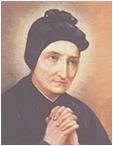 St. Magdalen of Canossa (1774-1835)
St. Magdalen of Canossa (1774-1835)
Founder, Congregation of
the Daughters of Charity
OR today.
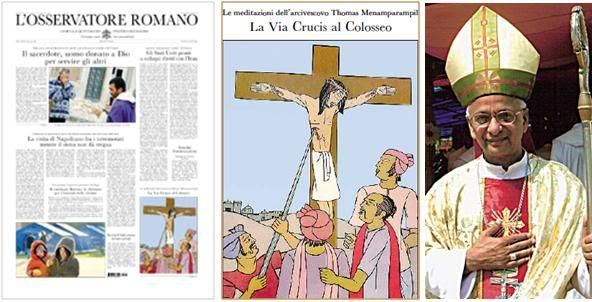
The issue carries the full text of Archbishop Thomas Menamparampil's meditations
and prayers for the Via Crucis at the Colosseum tonight.
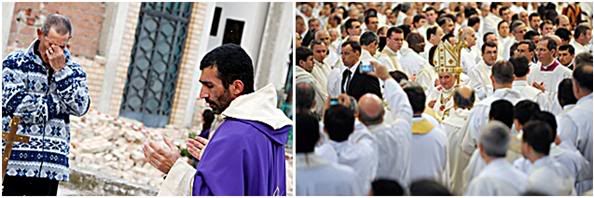
At the Chrismal Mass yesterday, Benedict XVI asks priests
to let themselves be guided by the Gospel:
'The priest, a man given by God to serve others'
(Left photo shows a priest ministering to earthquale victims in L'Aquila)
Other Page 1 stories: President Napolitano's visit to the earthquake victims; Cardinal Bertone to offer
funeral Mass at L'Aquila today for earthquake dead; and the United States ready for direct talks with Iran,
even as Iran celebrates its National Nuclear Day and Ahmadinejad boasts of progress in nuclear program.
THE POPE'S DAY

April 10
Good Friday
CELEBRATION OF THE PASSION OF THE LORD
Cappella Papale
17:00, St. Peter's Basilica
The Holy Father will preside at the Liturgy of the Word, Adoration of the Cross and the Communion rite.
VIA CRUCIS
21:15, Colosseum
The Holy Father will preside at the Stations of the Cross, after which he will address the faithful
and impart the Apostolic Blessing.
[Modificato da TERESA BENEDETTA 10/04/2009 14:07] |
 10/04/2009 13:42 10/04/2009 13:42 |
|
| | | OFFLINE | Post: 106 | Registrato il: 22/06/2005
| Utente Junior | |
|
il cardinale Bertone e segretario don Georg pregano nel elicottero durante la via da Roma e dopo visitano ospedale. video
E' bello il Papa!
www.benedictxvi.tv - video papale
www.benediktxvi.ru - Ratzinger-Inform agency |
 10/04/2009 13:51 10/04/2009 13:51 |
|
| | | OFFLINE | | Post: 17.101 | Registrato il: 28/08/2005
| Utente Gold | |
|

 A HYMN OF HOPE
A HYMN OF HOPE
Introduction
The meditations on the 14 Stations of the Cross will be introduced by the Holy Father
with the words from Mons. Menamparampil's Via Crucis libretto:
My dear brothers and sisters, we come to sing together a “hymn of hope”. We want to tell ourselves that all is not lost in hard times.
When bad news comes, one bit after another, we grow anxious. When misfortune hits us close to home, we grow disheartened. When we fall direct victims of a disaster, our self-confidence is totally shaken and our faith is put to the test. But all is not lost yet. Like Job we search for meaning (Cf. Job 1:13-2:10),
In this effort we have a model. Abraham believed and hoped, even when there was no reason for hoping (Rom 4:18).
Indeed, in testing times we see no reason for believing and hoping. And yet we believe. And yet we hope. This can happen in our personal lives. It happens in the wider society.
We ask ourselves with the Psalmist: “Why am I so sad? Why am I so troubled? I will put my hope in God” (Ps 42:6). We renew and strengthen our faith, and continue to trust in the Lord. For he saves those who have lost all hope.[4] And this hope does not ultimately disappoint us. (Cf Rom 5:5)
It is truly in Christ that we understand the full meaning of suffering. During this meditation, while we watch with anguish the painful side of Jesus’ suffering, we shall also give attention to its redemptive value.
It was God’s plan that the “Messiah had to suffer” (Acts 3:18; 26:23). and that these sufferings should be for us. (Cf. 1 Pet 2:21) An awareness of this fills us with living hope. (Cf. 1 Pet 1:3) It is this hope that keeps us joyful and patient in our troubles. (Cf. Rom 12:12)
A journey of faith and hope is a long spiritual journey, as we ponder the deeper design of God in the cosmic processes and the events of human history.
For, below the surface of cataclysmic calamities, wars, revolutions and conflicts of every kind, there is a quiet presence, there is purposeful divine action.
God stays hidden in the world, in society, in the universe. Science and technology reveal the marvels of his greatness and love: “There is no speech, nor are there words; their voice is not heard; yet their voice goes out through all the earth, and their words to the end of the world.” (Ps 19:3) God breathes hope.
God reveals his plans through his “word”, showing how he draws good out of evil both from the little events in our personal lives and the great happenings of human history. His “word” makes known the “rich and glorious” plan of God, which says that he frees us from our sins and that Christ is in you. (Col 1:27)
May this message of hope echo from the Hoang-Ho to Colorado, from the Himalayas to the Alps and the Andes, from the Mississipi to the Brahmaputra.
It says: “Be strong, and let your heart take courage, all you who hope in the Lord.” (Ps 31:26)
The full libretto in the English version is on
www.vatican.va/news_services/liturgy/2009/documents/ns_lit_doc_20090410_via-crucis...
Click on the pictures to get to the Meditation and Prayer corresponding to each station.
NB: It is thought that Benedict XVI's decision to assign the Via Crucis texts in 2008 to Cardinal Zen of Hongkong and this year to Archbishop Menamparampil of India, was in recognition of the persecutions undergone these days by the Church in China and India, respectively.
As the Introduction makes clear, however, these are meditations on the Way of the Cross that each one of us, individually. as well as collectively in our respective situations, must bear with Christ, as well as on accepting God's plan though we do not understand it.
It is a message that the Palestinian Christians should keep in mind (see article and comments 3 posts above).
[Modificato da TERESA BENEDETTA 10/04/2009 14:03] |
 10/04/2009 15:03 10/04/2009 15:03 |
|
| | | OFFLINE | | Post: 17.102 | Registrato il: 28/08/2005
| Utente Gold | |
|
 New Archbishop of Westminster
New Archbishop of Westminster
defends Pope's stance on condoms
by Ruth Gledhill, Religion Correspondent

April 10, 2009
The new Archbishop of Westminster today defended the Pope's stance on condoms and Aids and called for sexuality to be "humanised".
But he dodged the issue of whether the Church should advocate condom use as a health measure when one party in a marriage has aids or HIV.
[He was right not to be drawn into this nitpicking side issue. The Church has yet to take a definitive stance on it - the media have been speculating for years that this particular aspect is under study - but meanwhile, it is a private issue for the concerned couple and their confessor.]
The Most Rev Vincent Nichols, who will be installed at Westminster Roman Catholic cathedral in May, refused to comment on whether he would advise a faithful married couple to use condoms if one of them had AIDS.
Instead, he argued that Pope Benedict XVI had been misrepresented in his recent comments and that his aim had been to defend African women.
The Pope was greeted by a chorus of international condemnation after he told journalists during his recent visit to Africa that the rate of Aids and HIV infection on the continent was "a tragedy that cannot be overcome by money alone, that cannot be overcome through the distribution of condoms, which even aggravates the problems."
The Holy See did not dispute the Pope said this, but later altered the "official" record to indicate that what he had intended to say was that condoms "risk" aggravating the problems. [Fairness requires that Gledhill should also mention the Vatican restored the Pope;s original words after the tampering was pointed out, and that Fr. Lombardi addressed the misstep publicly.]
Archbishop Nichols, a conservative who, at 63, has a potential 27 years at Westminster, is likely at some stage to have no option but to state his position on an issue where the Catholic Church's official stance appears increasingly untenable. [Untenable only to those who advocate condoms and sex-at-any-cost, as well as those who follow them. Where is it written that abstinece is out of the question for a Catholic couple when one of the partners is infected?]
Many Catholic and non-Catholic Christians have no issue with the Church's stance on life issues generally, supporting its opposition to euthanasia, abortion and promiscuity.
But the Church's refusal even to consider sanctioning condom use as a health measure in countries where Aids is rampant is being condemned at the highest levels of scientific and intellectual debate in the West as ill-informed, unscientific and inhumane. [And here, there is blatant omission of the fact that equally authoritative levels (including the 'prestigious' British magazine Lancet which then turned around and ignored what it previously published, to lash out at the Pope) as well as objective data do support the Pope's statements. Like they do about the global warming issue, liberals will not even acknowledge objective facts that run counter to their ideological biases.]
Archbishop Nichols, asked on BBC Radio 4's Today programme about the Pope's statement that condoms can make Aids worse, said: "I am not sure that's exactly what he said at all. What he actually talked about was the need to humanise sexuality. And I think to some extent he was speaking up in protection of African women. And I think we face the same challenge."
Urging Catholics to protest against plans to liberalise television advertising for condoms and abortion advice services, he said: "The adverts at present on television for contraception actually are demeaning of young people. They depict two people having sex on a street corner and some more just in a drunken orgy, and that is not a fair representation of young people today. We really need to do an awful lot to raise expectations of each other and to humanise sexuality, to use the Holy Father's phrase." [This part of Archbishop Nichols's statements deserves a headline and separate story of its own!]
Asked whether he would suggest condom use to a married faithful catholic couple who came to him for advice where one of them had Aids, he said: "Well obviously that's a very sensitive point and obviously there are different views on that."
Asked what his own view was, he insisted: "No, no, that's not what this public debate is about."
He continued by arguing that he wanted to pursue the point about humanising sexuality.
"We really do have to raise people's expectatins about themselves. Today is Good Friday. What do we celebrate today? We celebrate this enormous gift of God's love to us, which teaches us how much dignity we have, and we have to encourage as a society people to live off their best instincts, their best generosity and not constantly be portraying our society as degraded and in need of elastoplast all the time."
AIDS and condoms:
Morality and lives
by Donald DeMarco

April 19-25, 2009 Issue
An associate professor of political science at a Catholic university has ruffled a few feathers with a newspaper article entitled “Pope Puts Doctrine Ahead of Lives.”
The author was referring to Benedict XVI’s recent visit to Africa and his “stubborn” opposition to the use of condoms. This is enough, according to the author, to make the Holy Father “a preacher of death.”
So now we know that the Pope is promoting the culture of death while, presumably, the secular world is promoting the culture of life.
The Sixth Commandment forbids adultery. Does the use of the condom rescind this interdict? Does the modernized version read: “You may commit adultery as long as you use a condom”? Does latex replace the confessional? Was it a shock to the major media that Benedict XVI did not toss aside the Sixth Commandment?
[It spoils the whole presentation that the writer inexplicably associates condom use only with adultery, when condom users include many who indulge in premarital sex or who are, in fact, married couples!]
It is an extraordinary thing to place greater faith in a band of latex than in Christianity, prayer, virtue and Catholic teaching.
Where a program of chastity and premarital abstinence is used, such as in Uganda, the rate of AIDS has gone down by half during the last decade. Congressman Chris Smith has witnessed and reported on the positive results of the abstinence message when he toured Uganda.
Dorothy Kwanze, a HIV activist in Kenya, has reported, “Abstinence education remains the best strategy, especially for the risk group aged 15-25. The concept has worked well for Uganda and can work for other African countries.”
Fortunately, Ms. Kwanze is not influenced by gross media distortions such as what is found in some American newspapers.
Our misguided political scientist suggests, rhetorically, that, “Perhaps the Pope doesn’t know that 12 million people in sub-Saharan Africa are suffering with the disease [HIV/AIDS].” [PUH-LEEZE! Few leaders could be better informed about disease statistics in Africa than the Pope who gets regular reports from Catholic missions and bishops on what they do!]
What the Pope does know is that the promotion of premarital abstinence works very nicely. Uganda once had the highest HIV infection rate in the world. In the 1990’s, 30% of the country’s population was infected. Today’s rate (2009) is down to about 8%.
The headline, accusing the Pope of putting “doctrine ahead of lives,” is scurrilous journalism at its worst.
The author, of course, is not without his own doctrine, which is barbaric in its essence. Widespread fornication, together with its negative impact on marriage, the family and personal integrity, appears to be of no concern to him. Would a wife be satisfied to know that her philandering husband always uses a condom?
The author feigns an interest in the lives of those infected or those who may be infected by the HIV virus, but his unremittingly vicious attack on the Holy Father certainly calls into question his supposed altruism.
He refers to the Holy Father as “immoral,” offering a “ridiculous belief,” expressing an “abhorrent motive,” and spreading a “general fear of sexuality,” while showing a “disregard if not contempt” for the people of Africa,” and, “instead of praying for those in need,” “preying on them.”
This is a fairly comprehensive, though recklessly intemperate, swipe that is seldom levied against even the most villainous of criminals.
The Church is concerned about saving souls as well as lives.
Condoms do not always work. They have both user as well as product failure rates. To be concerned exclusively with lives, but not with their moral quality, is not only irresponsible, but a sin against charity. The Church is vitally concerned about both, but the moral dimension must take precedence. To those who are good, good things will follow: “Blessed are the pure of heart, for they shall see God” (Matthew 5:8).
This is surely the message of Christ when he bids us to seek first justice and the Kingdom of heaven. To countenance out-of-control sex is not an expression of love. But to believe that a thin layer of latex is Africa’s most pressing need is superstition in its most virulent form.
Morality must come first. If it does not, immorality will grow without check.
And this is why Pope Benedict stated that the distribution of condoms “increases the problem.” When morality is ignored, immorality grows by leaps and bounds.
The Church is supposed to move the world, though the world is certainly intent on moving the Church. The Church is a light.
Yet, that light is sometimes sent into a darkness that is so impenetrable that it cannot receive it. The venomous and slanderous attack on the Holy Father is a recurrence of the attack against Christ, which is also an attack against the light. “Let there be light” should be the maxim of all newspapers, secular as well as religious.
Donald DeMarco is a professor emeritus at St. Jerome’s University and an adjunct professor at Holy Apostles College and Seminary and Mater Ecclesiae College.
Certainly not the most solid piece of commentary on the issue but certainly well-intentioned....
[Modificato da TERESA BENEDETTA 11/04/2009 08:40] |
|
|
|
|